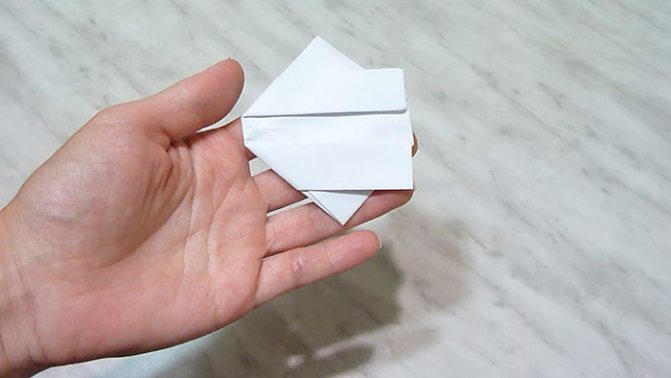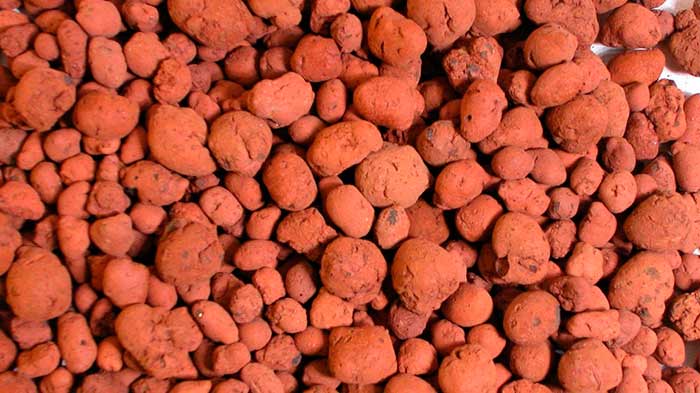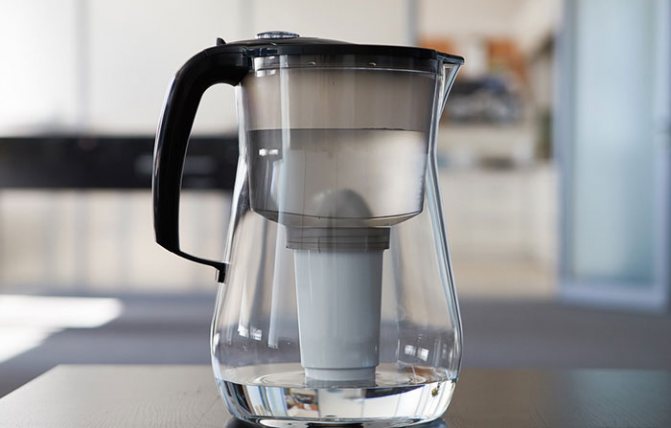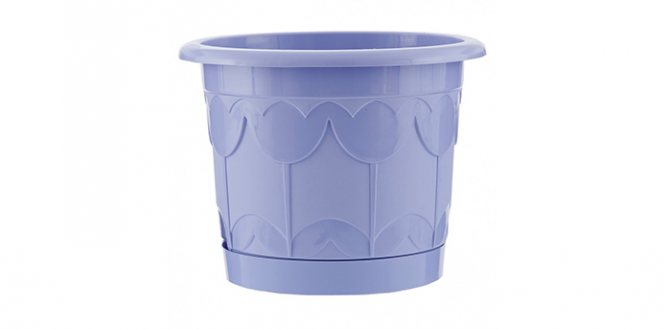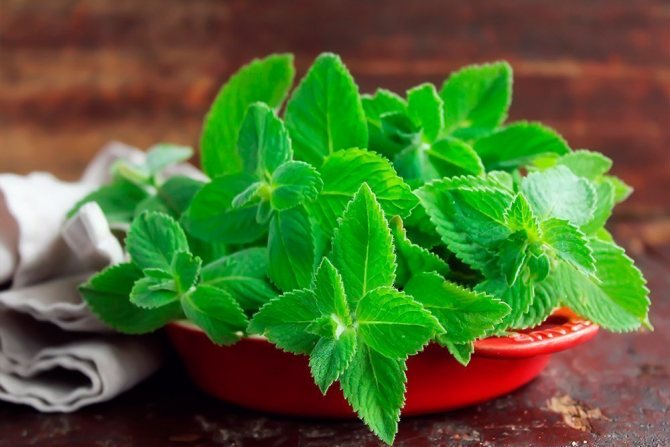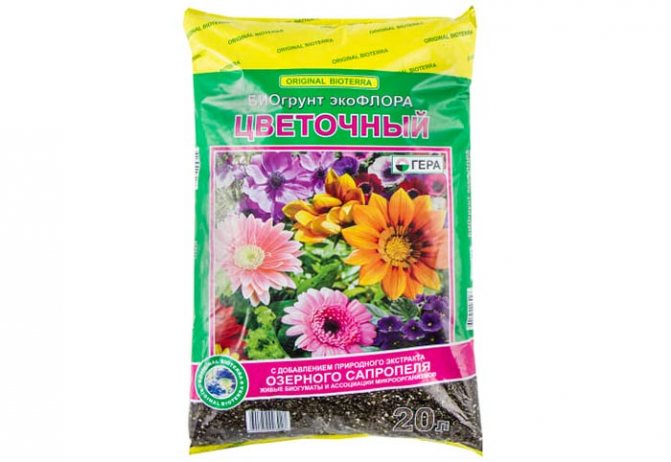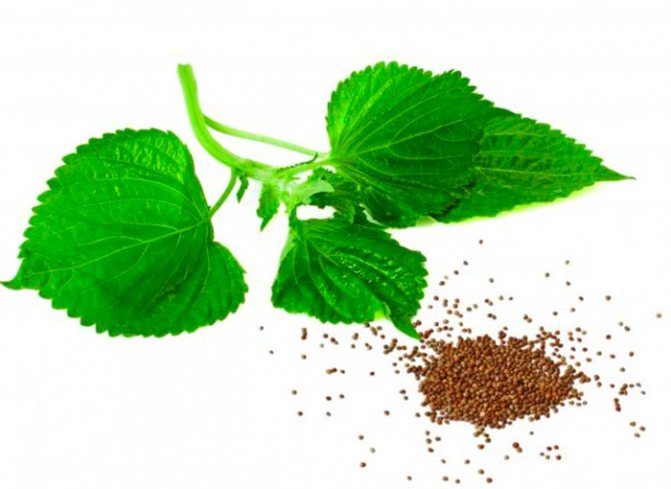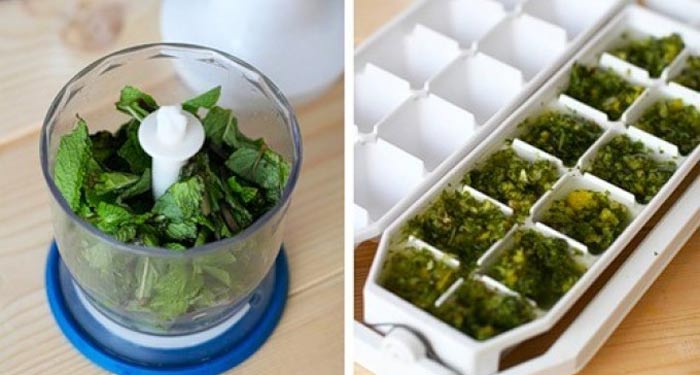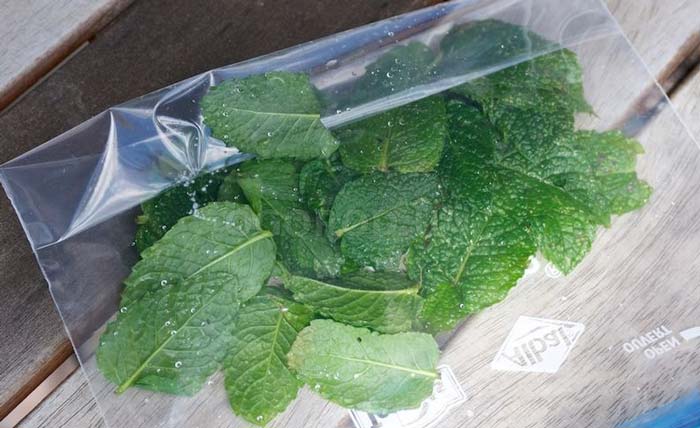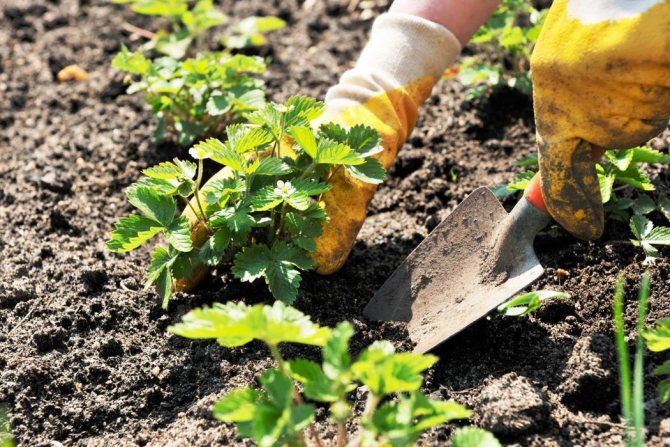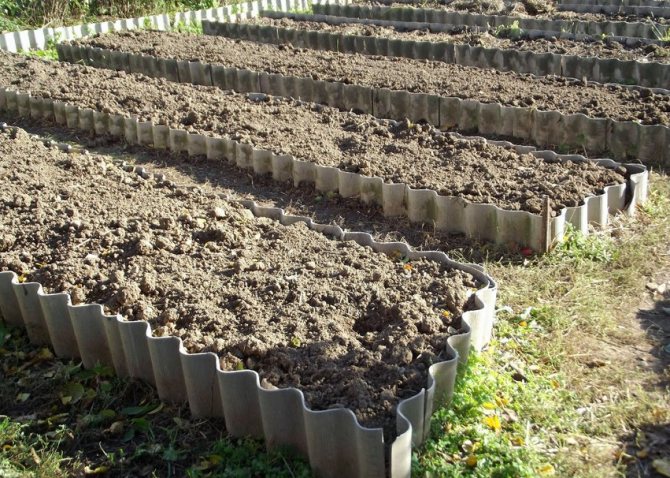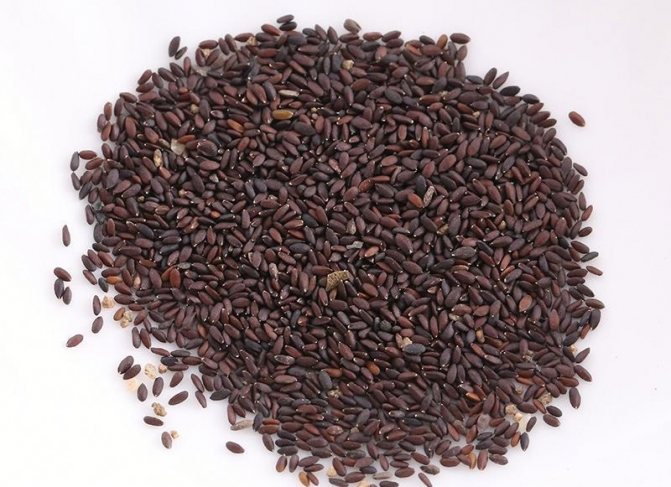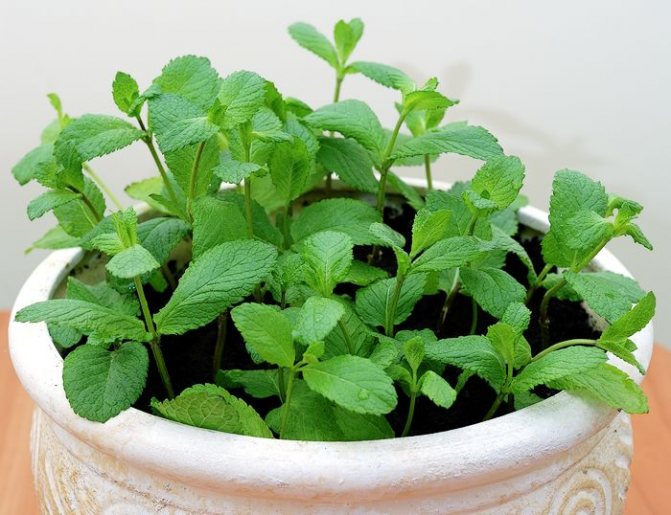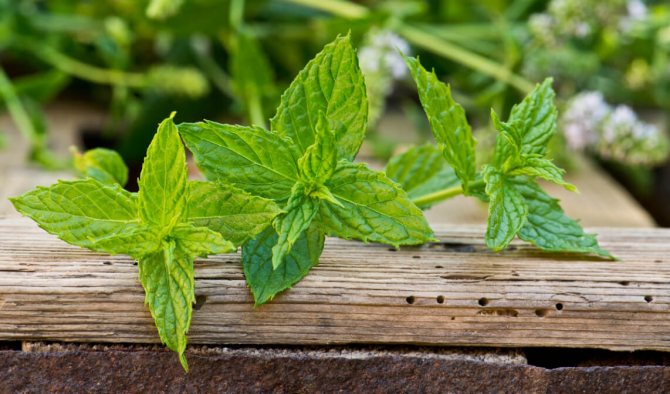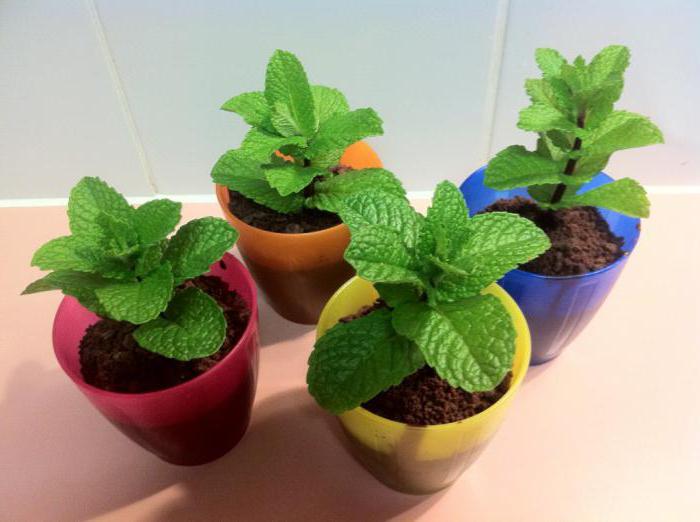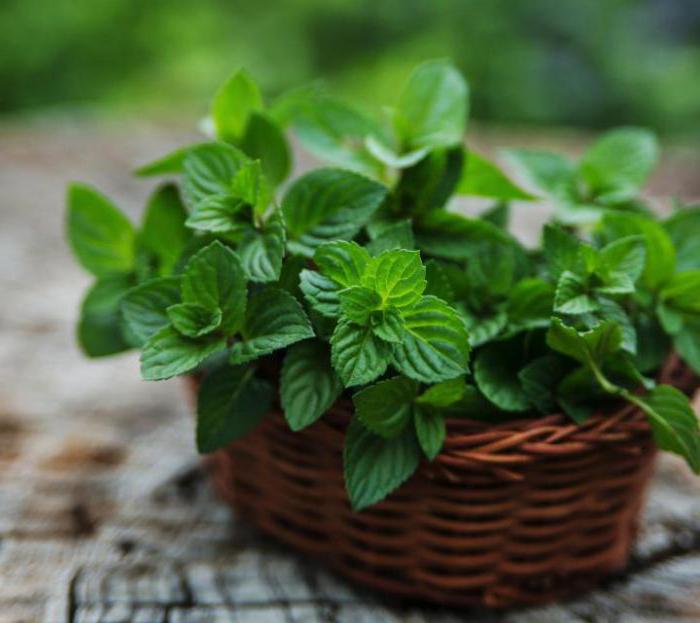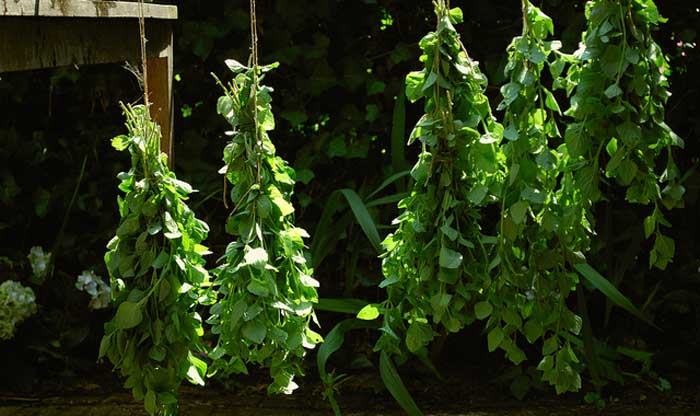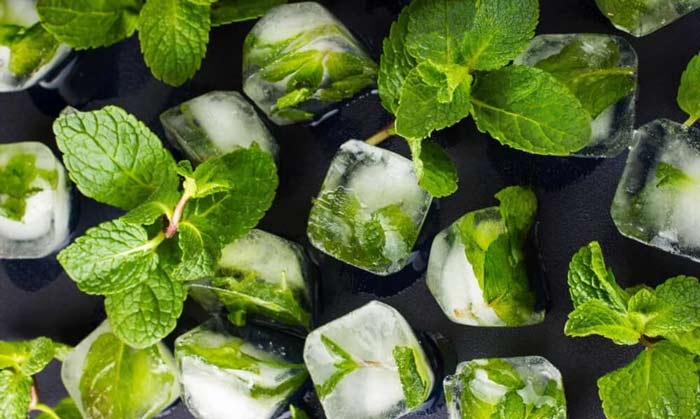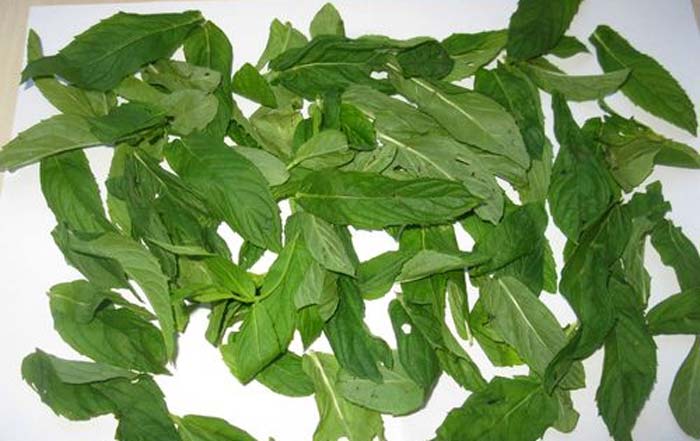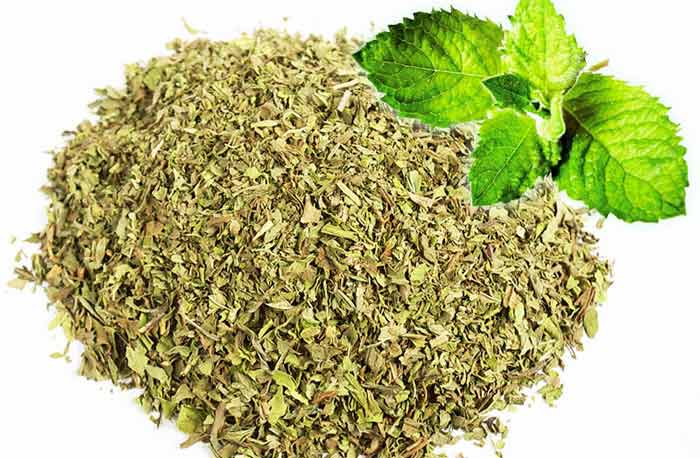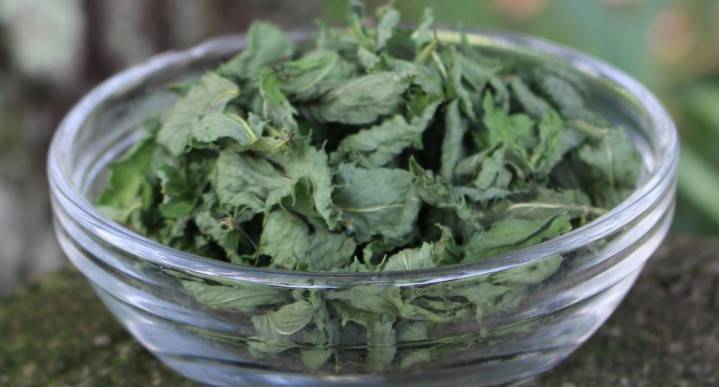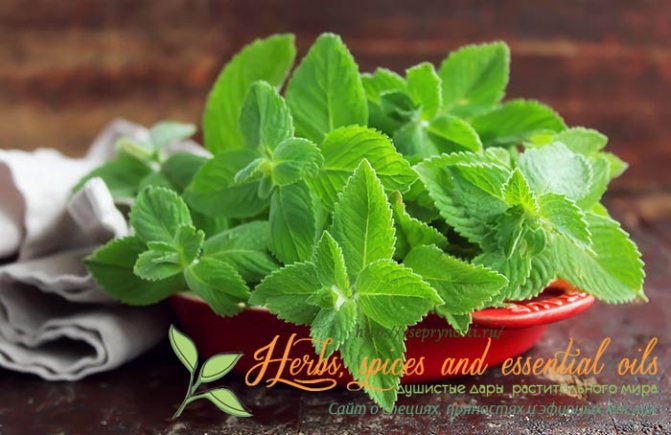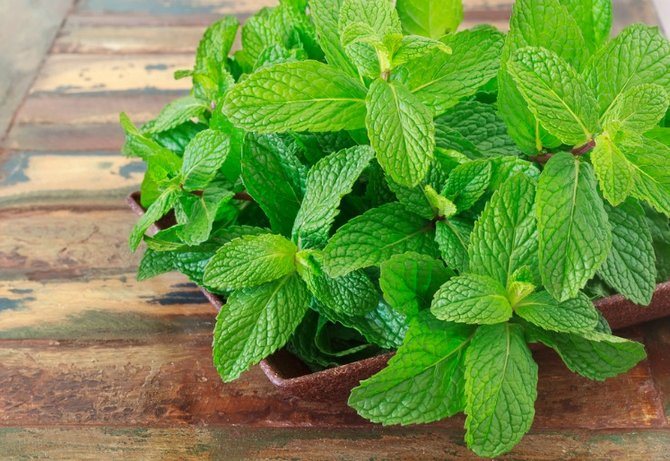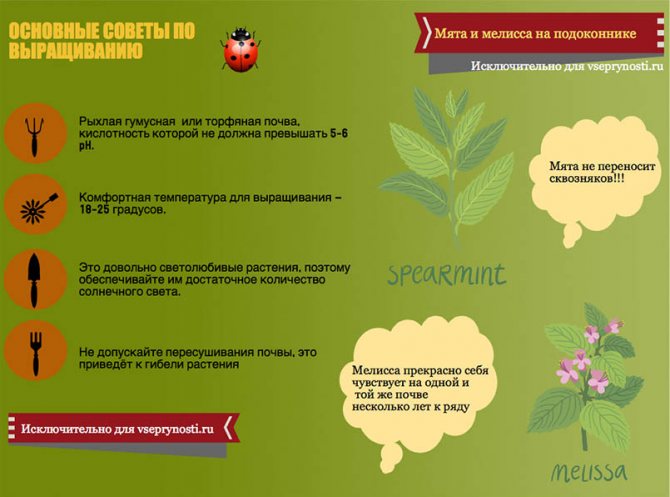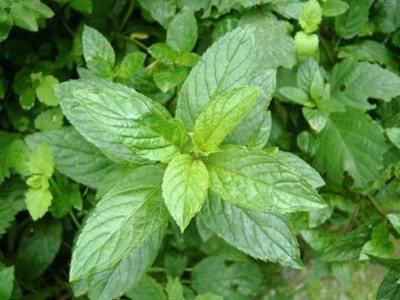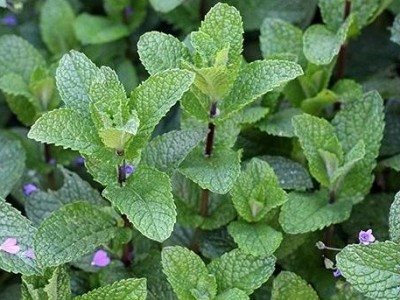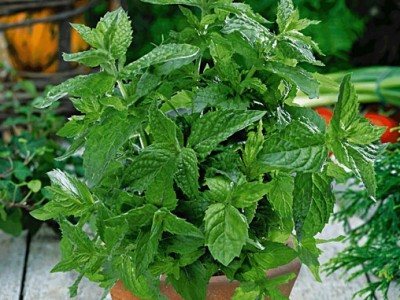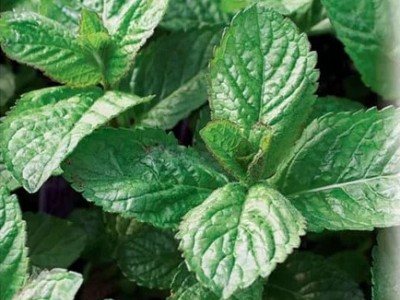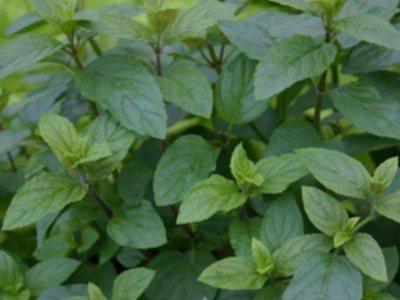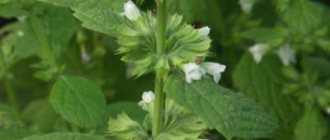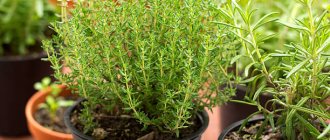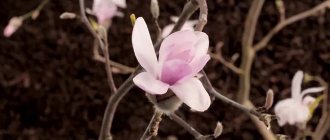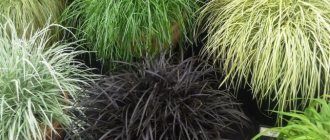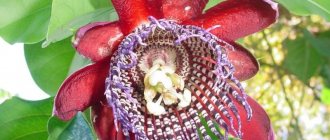Useful article - an overview of how mint grows on the windowsill, as well as its relative, the herb lemon balm. Secrets of planting, care, selection of seeds, watering, harvesting.
Mint and lemon balm are very common and beloved by everyone, without exception, spicy aromatic plants.
Many people know about their most valuable medicinal properties and use these gifts of nature for the benefit of their health.
Melissa and mint on the windowsill - how to grow and have a fresh spice at your fingertips all year round? This will be discussed below.
How to grow mint at home?
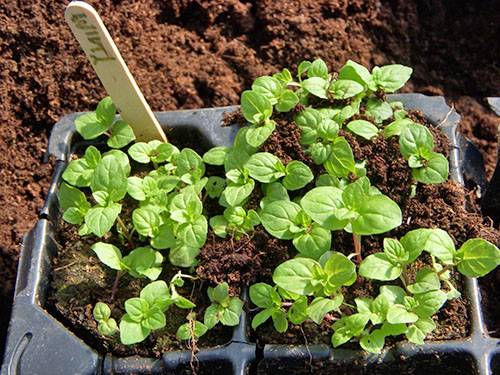
A perennial with a branched surface rhizome and many shoots extending from it can be easily grown at home. The main thing is to provide the plants with comfortable conditions, including adequate nutrition, lighting and watering.
Mint feels best on loose soils with an average organic content and low acidity, in the range of 5-7 pH.
Before planting mint for plants, a soil mixture is prepared from two parts of garden soil, one part of humus, the same volume of peat and washed sand. To prevent the mint roots from getting wet, and there is no danger of decay, drainage must be done in a container for growing mint at home.
Since mint is quite unpretentious, you can propagate the plant:
- sowing seeds;
- root layers;
- cuttings;
- dividing an adult bush.
What do you need to grow mint?
Growing mint at home must be approached with certain knowledge. The seedlings require suitable planting containers and soil conditions. It is important to take into account the temperature and humidity indicators at which the culture will grow safely.
Choosing the best place in the house
Choosing the right sill is extremely important for the full growth of the seedlings. The plant likes places with sufficient sunlight. But the light should be diffused, not direct, since the intense rays burn thin seedlings. Therefore, the best option is to install the pot on a western or eastern window sill.
Selection and preparation of containers
The mint root system is characterized not by deepening into the ground, but by expansion. Therefore, you need to choose not deep, but rather wide planting containers.
The bottom should be equipped with drainage. If there are no drain holes, they are either made independently, or a claydite layer up to 3 cm thick is used.
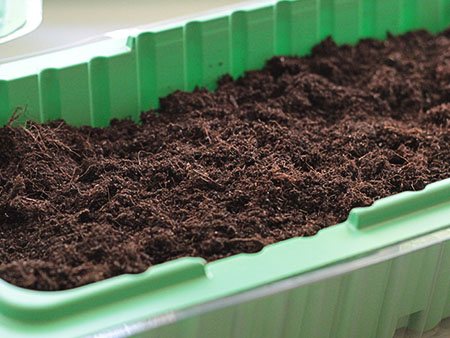

Soil selection
Mint is picky about the soil. But in order for it to grow more actively, it is advisable to make a nutritious soil with a loose structure. The best option is a mixture of peat and fine sand.
Preparing seeds and cuttings for planting
You can plant a non-capricious plant by the following methods:
- Seeds;
- Root layers;
- By cuttings.
Attention should be paid to the preparation of the material for planting. The ripe seed can be taken from the plant on the site. You cannot take more green seeds: there will be no shoots.
But the cuttings cut from an adult plant must be prepared. A stalk up to 10 cm long is placed in water, left until the roots are released. Then it is transferred to moist soil. The roots will quickly appear provided that the cut offshoot is found in a warm and sufficiently humid room.Do not delay planting: you need to transfer the seedling to the soil when the roots are still short, less prone to damage.
Creation of the necessary conditions
Seedlings are extremely sensitive to moisture levels. Therefore, in the summer heat and in winter, when the batteries dry out the air in the room, it is necessary to regularly spray the young greens with settled water.
The optimum temperature at which the sprout develops rapidly is between + 22 ° C and + 25 ° C. With a decrease in temperature, growth processes are inhibited. This property of the plant is used for wintering: they are installed indoors from + 18 ° C to + 20 ° C, so that growth slows down, the shoots rested until spring.
How to grow mint from seeds on a windowsill?
Seed propagation is the most laborious and time consuming method, but it cannot be avoided if you want to get a plant of a certain variety or type.
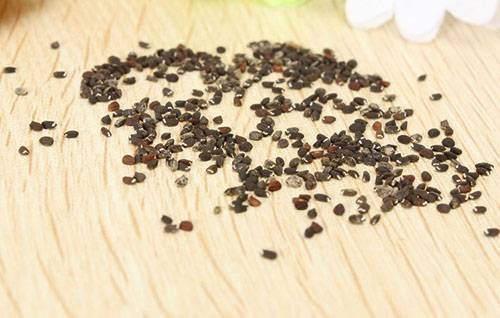

In order for the seedlings to be strong and friendly, it is better to give preference to purchased seeds. Not all hybrid species inherit the parental characteristics when collecting seed from them. So, for example, only a third of curly mint seedlings have curly foliage, and the rest of the seedlings are a simple garden variety. So how to plant mint seeds?
It is better to sow mint in March or April, in moistened soil to a depth of 0.5 cm. Sprinkle the seeds on top with a small amount of humus or nutrient soil and cover with glass or film. At room temperature, seedlings appear 14-18 days after sowing. Until this moment, it is necessary to monitor the moisture content of the soil, to prevent it from drying out or waterlogging. If necessary, the surface of the soil is carefully sprayed, trying not to disturb the small seeds, and the glass is slightly opened for ventilation.
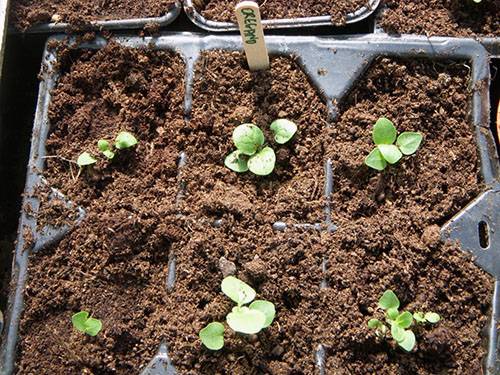

When the sprouts of mint on the windowsill give two true leaves, they are dived, seated in separate small containers or in a 5x5 pattern in a single wide container.
How to grow mint properly
The selection of the planting capacity is a very important point, the pot for planting mint should be wide and low. This is due to the fact that mint has a strong and branched root system, which will be uncomfortable in a small box. The soil must contain a large amount of peat. If you decide to use land from a summer cottage, and not from a specialized store, it is better to choose a more fertile mixture with a high content of useful trace elements and then the plant will develop well. Having decided to choose soil from the garden, you cannot just pour it into a pot.
Disinfection of the earth with a manganese solution is required, and after calcination with boiling water or rinsing with water. These procedures are necessary to reduce bacteria in the soil that can infect the plant and, as a result, it will get sick. Growing mint is possible in two different ways: mint seeds and mint cuttings.
It all depends only on how quickly the harvest of mint is needed and what you want to get in the end.
Cutting method - in the fall, you should dig up an adult plant and divide it into seedlings without damaging the roots. A large and voluminous bush of mint should be divided into several parts with some buds and stem shoots. Before direct planting, the cutting is rooted in sand or in a jar of water until the roots grow back on the plant. At the bottom of the container in which the mint will be placed, drainage is needed, then a layer of prepared earth. The earth is well moistened and covered with mint roots with shoots. After 2-3 weeks, green leaves will appear on the stem, after which the whole plant should be fed.
Top dressing is performed from urea (carbamide) 1-2 grams per liter of water. In the winter period, the plant does not need feeding. Mint loves a well-lit place at any time of the year, but in the summer you need to watch out and not let the mint ground dry out and crack. Watering is necessary with water only at room temperature.A plant grown by cuttings will be a copy from a dug bush in the fall.
Planting mint seeds gives first shoots in three weeks, and the bush is formed within two months. A grown plant will be tender and cuddly, while a cuttings plant will have mature and firm stems. Mint tends to be pollinated and the bush that is painted on the package of seeds cannot always grow. Therefore, you should plant several types of mint and plant them in peas together (for example: pepper and plectrantus or any other type).
In order to start planting seeds, they should be laid out on the ground, where they should be no deeper than half a centimeter. The first shoots will appear in 2-3 weeks. For a low height, the plant should be placed in a well-lit place or illuminated with artificial lamps. Watering at first is done only from a spray bottle.
How to plant mint by root layers and dividing the bush?
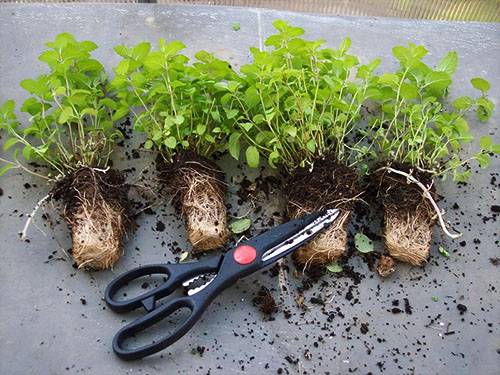

Gardeners and gardeners know how the mint that has taken root on the site quickly takes up new spaces. Long rhizomes with dormant buds are to blame for the predatory activity of the plant. The expanding root system of one plant gives life to new shoots and bushes. How to plant mint with root cuttings?
If you take advantage of this feature of mint, and in August or September stock up on root cuttings, about 10-12 cm long and two or three buds, then there will be no difficulty in the question of how to grow mint at home. Root layers are planted in moistened soil to a depth of 5–7 cm. If there are already developed shoots on such a cuttings, the roots are carefully preserved, and the aboveground part, after sprinkling with soil, is cut off at a height of 4–5 cm. The same is done with the planting material obtained after dividing the whole bush.
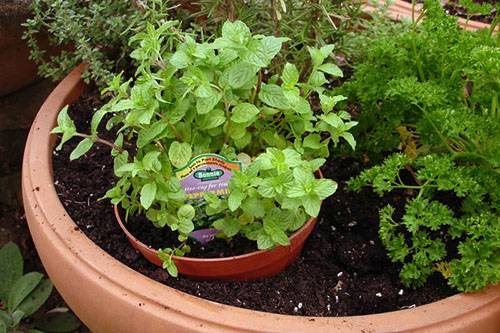

After two weeks, with proper care, indoor mint, as in the photo, forms dense green shoots and the first odorous leaves above the soil.
The same breeding methods are suitable for planting on the windowsill such herbs as oregano and thyme, which belong together with mint to the same family and have common habits and characteristics.
All of these crops are grown at home as perennials and require light but constant care.
Growing mint with root layers
Long, diverging roots of mint have dormant buds. Therefore, the plant can be propagated by means of root layers. Below is the instruction:
- At the end of summer, take root cuts up to 12 cm long, with 2-3 buds.
- They are immersed in moist soil by 5-6 cm.
- If the buds have already woken up at the root, released shoots, then the aerial parts after planting are cut off about 5 cm from the top.
- The buds wake up, sprout on average 2 weeks after planting.
Growing mint at home using cuttings
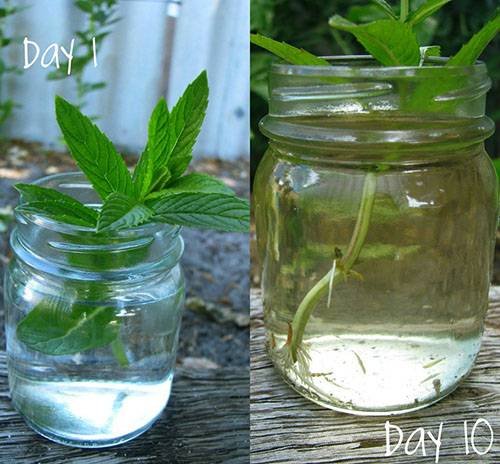

Cuttings cut from the tip of the shoots of an adult bush are also suitable as planting material for growing mint on the windowsill. How to grow mint on the windowsill in this case? Twigs 6–8 cm long are dipped in a root solution and, after removing the two lower leaves, are placed in water. Roots sufficient for planting in the ground are formed after 7-15 days.
Two weeks after planting the rooted cuttings and the appearance of shoots on the planted root processes, the plants are fed with urea at the rate of 1 gram per liter of water.
Grow mint as an adult bush
To do this, in the fall, we choose a pretty neat bush in the garden. Together with a small lump of earth, we transfer it to the pot. The capacity should be large enough, because the mint root system is of a decent volume.
We add a little humus so that the bush does not stagger in the pot. At the same time, this will be the nutrition of the plant for the first time.Now you need to periodically water the mint and be sure to arrange additional lighting. For normal development, you need at least 12 hours of daylight hours. Otherwise, the leaves will be pale, stunted and practically odorless.
By the way, you need to water the mint only after the top layer of the soil has dried. She does not like to swim with her roots in a swamp, so after watering, be sure to drain the excess liquid from the pan.
The temperature of the mint content on the windowsill should not exceed + 25 ° C. Otherwise, the plant will simply begin to dry out and turn yellow. And all your attempts to drain it with water will end in root rot.
Advice. Tear off young leaves often. This stimulates the growth of new shoots.
Caring for mint grown on a windowsill
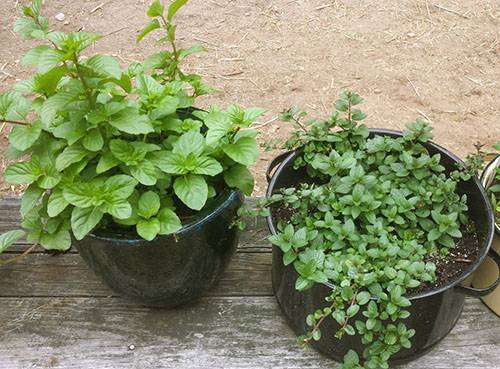

When wondering how to grow mint at home and get strong bushes with juicy bright foliage on the windowsill, it is important to remember that this is possible only if there is the correct temperature regime, watering and sufficient illumination.
The temperature comfortable for growth is 20–25 ° С. With this mode, long daylight hours and moist soil, plants form foliage well.
Mint reacts sensitively to changes in illumination, in room conditions, without additional 6-hour illumination in autumn and winter, its shoots begin to stretch, the leaves become smaller, lose their rich color and aroma. If it is impossible to organize the necessary artificial lighting of pots with mint on the windowsill, you can lower the temperature to 15-17 ° C and limit watering. This measure will somewhat slow down the growth processes and will not allow the quality of greenery to decrease.
With all the love of mint for light, the plant does not tolerate being in the sun in direct sunlight. Exposed to the balcony, terrace, loggia or on the windowsill, mint must be shaded, protecting the planting from burns and drying out.
In rooms with a dry atmosphere, especially when heating devices are working, a container with water can be placed next to the mint so that the air humidity does not fall below 80%, which can adversely affect the condition of the bush. For the same purpose, for mint on summer days and in winter, in a warm room, irrigation is carried out with water at room temperature.
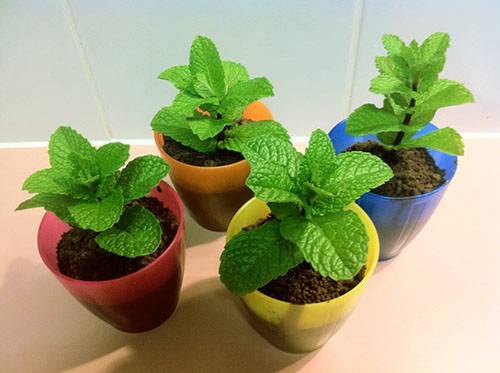

As well as excessive dryness of the air, mint on the windowsill also does not tolerate drying out of the soil. The soil is watered at the first signs of dryness of the upper layer, but at the same time they do not allow stagnation of moisture, which is detrimental to the roots. With a decrease in air temperature, the need for irrigation drops slightly.
To simplify the care, as in the photo, for room mint, a little hydrogel can be added to the soil for planting it. Several granules in the soil layer above the drain will allow the soil to retain moisture and fertilizer better.
It is necessary to feed mint grown for greens using nitrogen, potassium and phosphorus fertilizers, but very carefully, since with an excess of nitrogen, the plant can accumulate it in the green.
Difficulties in growing
Despite the fact that mint is an unassuming plant to care for, not all gardeners manage to grow a healthy shrub. The reason for this may be not only improper care or planting, but also the defeat of shrubs with diseases and parasites.
Diseases
Mint is often infected with fungal infections. The most common diseases include powdery mildew and rust. In the first case, the leaves and shoots of the plant are covered with a bloom resembling flour. Infected shrubs cannot be treated - they are removed from the site and burned.
When infected with rust, reddish spots appear on the mint foliage. The disease spreads instantly to all organs of the plant and passes to healthy specimens. Therefore, if found, the infected areas should be cut and burned.
Pests
Despite the fact that it is not difficult to grow a culture, it is plagued by many parasites. There are several pests that are characteristic of the spice plant.
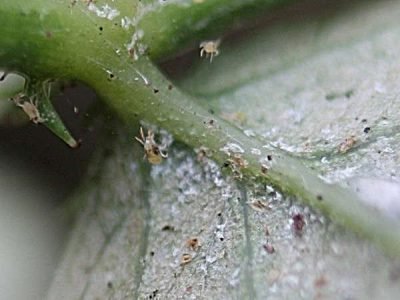

Spider mite
- Aphid.You can determine that this pest has appeared on the foliage by the folding and drying leaves. Insects settle in whole colonies on the inner side of the leaves, multiply rapidly and feed on the juice of the shoots. There are several means with which you can get rid of aphids - ash-soap, garlic-water, soap-tobacco solutions. Processing is carried out twice with a frequency of 10 days. They spray not only the crown, but also the soil around the plant.
- Mint flea. This is another parasite that loves to feast on the delicate and juicy mint foliage. It is difficult to exterminate it, but it is possible. Some gardeners sprinkle the crown of the shrub with stove ash, others spray it with soapy water.
- Leaf beetle. The numerous holes in the mint leaves are the first sign of the appearance of this pest. At an advanced stage, only one vein may remain from the foliage, therefore, in case of infection, the mint must be urgently saved. The same means are used as for the destruction of aphids.
- Spider mite. A microscopic insect envelops the leaves and shoots of the plant with its small cobweb. It feeds on the sap of the foliage, as a result of which the leaves begin to wilt, then curl, dry out and crumble. An ash-and-soap solution is used against spider mites.
- Leaf roll. Caterpillars of this pest roll mint leaves into a tube, feed on the juice of the leaves. Adults are no less dangerous - they lay eggs on all organs of the plant, from which caterpillars hatch. In case of minor damage, the larvae can be harvested by hand together with twisted foliage. Butterflies are caught at night under artificial light.
All treatments for parasites are carried out at least 2 weeks before the planned harvest. After the treatment, the crown is sprinkled.
Timing of collecting mint at home
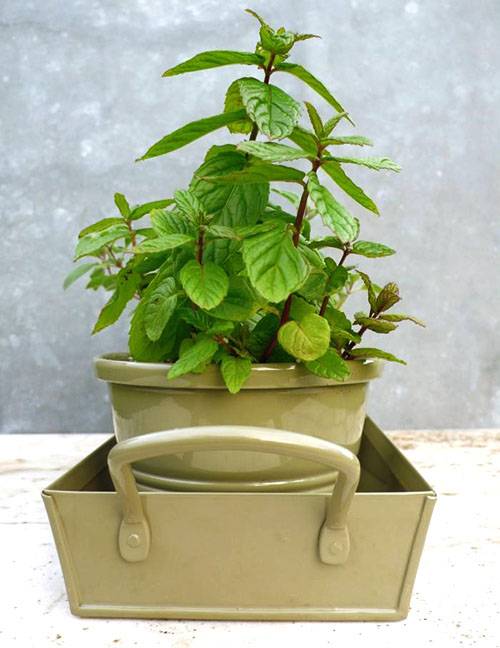

The first crop of home-grown mint is harvested within 15–20 days after the first leaves appear above the ground. By this time, mint bushes reach a height of 20-30 cm, while trimming the tops of the shoots leads to the awakening of the buds in the axils and the growth of the plant.
If mint is grown in order to obtain raw materials with the maximum content of useful essential oils, then the timing of mint harvesting falls on the moment of peduncle formation or the beginning of flowering. In this case, during the warm season, when growth is most active, you can get up to three full harvests.
Mint, melisa on the windowsill - video
www.glav-
Care
Caring for the plant is not very difficult, the main attention should be paid to the moisture content of both the soil and the stems themselves. The soil itself should be moist, but never wet, otherwise the roots can rot, so the looseness of the soil and the drainage system in your tank are also important. Considering that mint is grown on the windowsill in winter, it is worth making sure that the soil does not dry out due to the proximity to the battery, and moisten the stem by spraying moisture onto the leaves. Note that the plant slows down the growth process in winter, so watering and feeding should be very moderate. The main enemies of mint when growing at home is a draft, therefore, deciding to ventilate the room, take care to rearrange the plant in a cozy and warm place in the room.
The main parameters for caring for mint at home
Watering mint plants in the initial period, when the seedlings have not yet matured, you need to often. At such a moment, plants need a constantly moist soil. Since all nutrients are directed to growth processes. And the drying out of the soil will significantly slow down this process.
Well-rooted mature plants need to water as it dries substrate.
After watering, you can loosen the soil for more oxygen to the plant roots.
Humidity for mint must be kept in the range of 70 to 75 percent.Low humidity will dry out the tips of the leaves, and high humidity will provoke the onset of disease. Therefore, you need to keep this fine line.
For normal growth and development of the plant likes well-lit places... At the same time, mint should not spend a lot of time under the scorching rays of the sun.
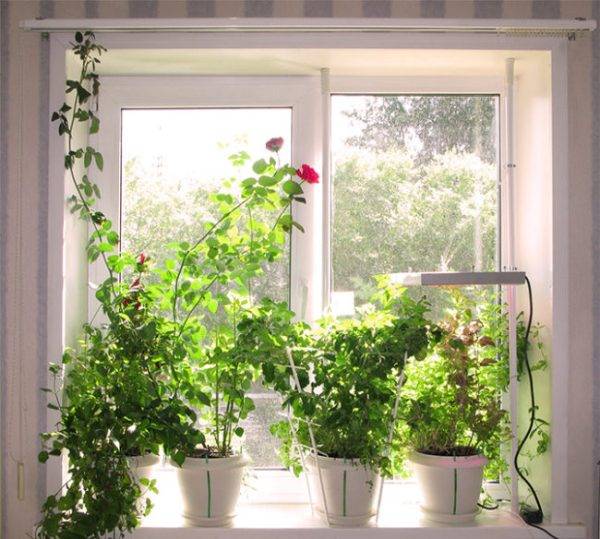

Additional lighting mint on the windowsill
Insufficient lighting will depress the plant. Growth processes will be disrupted and the mint will slowly wither away. To prevent this, in this case, you need to use artificial lighting. You can use special lamps for growing seedlings. They contain a special spectrum of light, which is necessary for plants.
If it is possible to take plants to the balcony, then the plant will only benefit from this. Fresh air will allow the plant to better absorb and use the necessary nutrients for their intended purpose in order to successfully reproduce in the future.
The soil for mint should be porous, not heavy. Such a substrate will absorb and release moisture well, as well as provide adequate oxygen access to the plant's root system.
If you grow mint at home, then it is advisable to feed it with complex fertilizers. This will be enough. When grown outdoors, slightly fertilized organic areas are suitable for mint.
Top dressing must be carried out during the spring and summer months. It is best to do this with watering or before watering. Fertilizers are well absorbed in the wet state of the soil.
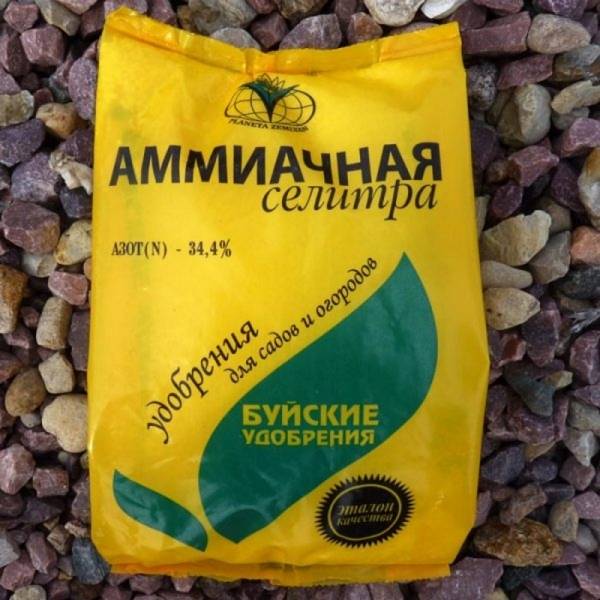

Top dressing of mint with ammonium nitrate
Since we need the green mass of the plant from mint, we can feed it with ammonium nitrate. This will allow the aerial part of the plant and large leaves to grow quickly.
At home you can do without feeding, in the event that the substrate already has the required amount of macro and microelements.
One of the most dangerous diseases for mint is rust... Fungal type disease. The causes of the disease are as follows:
- reduced temperature conditions
- high air humidity
- excess nitrogen accumulation
The first signs of the manifestation of the disease are the appearance of dark red spots in the form of pads on the underside of the leaf blades.
The disease usually appears between July and early autumn months. Treatment with a 1% solution of colloidal sulfur will help get rid of powdery mildew.
Another fungal-type disease is verticillary wilting... The disease affects the leaves. Their edges begin to blacken, and the leaves completely die off. Then the plant also dies. In order to prevent mint from being affected by this disease, breeders have developed specially resistant varieties. One of these varieties, for example, is Prilukskaya mint.
Also, mint can be affected by diseases such as:
The plant attracts to itself mint flea... This bug is one and a half millimeters long, yellow in color. It makes holes in the form of a circle on the sheet plates. Appears with the arrival of warm and dry spring days. Leaves are damaged in much the same way. green scale insects, which also gnaw at the edges of the leaves.
Round holes makes and leaf beetle.
One of the most dangerous pests for mint is aphid... It is a small green insect that sucks sap from young leaves and apical growth points. Aphids grow very quickly and can destroy the plant completely. She is a carrier of viral diseases. This type of damage inflicts leafhoppers.
In addition to these pests, mint can be damaged:
- weevil beetle
- meadow moth
- mint mites and other pests
In order to prevent damage to the plant by diseases or damage by pests, it is necessary to strictly follow the basic rules for caring for the plant.Timely watering, proper lighting, feeding, a well-ventilated room, as well as maintaining optimal temperature and humidity will help mint create a strong immunity. This will allow the plant to always be in a vigorous state. It will form powerful shoots and large leaves.
It doesn't take a lot of effort to grow mint on your windowsill or in your garden. Although you need to know the basic points of plant care. I hope that this information will help you to understand this issue well and grow a beautiful and fragrant mint.
btf.su
Video "How to grow mint greens in a few days"
A demonstration video for those who want to grow healthy greens at home in a few days.
Mint is a unique perennial plant whose valuable properties are appreciated by many gardeners. It is used in cooking, to brew delicious aromatic tea, and to treat some colds.
That is why many are trying to cultivate it not only in the country, but also at home. This can be done with cuttings and seeds.
Mint is a fragrant, gentle and refreshing herb that belongs to the Lamiaceae family. It is not demanding on the climate and the growing region, therefore it is grown by many gardeners in the country. But its widespread use in cooking leads to the need for many housewives to grow it at home.
Mint is widespread in different regions of our country, while it has more than 300 different species, but only 20-25 varieties are most widespread.
Among them it is worth highlighting:
- long-leaved;
- spikelet;
- field;
- apple;
- water;
- green;
- curly.
Unlike other horticultural crops, this plant has a menthol refreshing scent that is slightly weaker in pepper than in other varieties. Depending on the variety, it can have a green or reddish-purple color of leaves and stems. In this case, cultivation can be carried out in different ways.
You can plant it both with the help of a cuttings and with seeds. At the same time, for growing at home, novice gardeners generally choose the first option, since it is easy to implement. The second method is more complicated, since the use of seeds to obtain seedlings is a laborious and time-consuming process.
Mint cuttings
But if all the requirements and recommendations are followed, any housewife, even a very busy one, will be able to grow viable seedlings at home. Mint is a fairly undemanding plant, so it does not need regular watering, feeding and replanting.
Growing mint using seeds is a long, laborious and complex process, since it requires increased attention, without which the seedlings can die. Also, the seeds do not guarantee full germination, therefore, even when using a whole bag of them, only a few seedlings can sprout.
Another factor that is important to consider when using this method is the fact that hybrid varieties, when propagated and grown by seed, can produce a plant that is different from the mother. Such varieties-hybrids include pepper, Dutch and others.
This method is preferable to use if planting is carried out in winter, and the seeds cannot be collected from the mother. In this case, a bag of planting material of a certain type (curly, peppery, lemon, long-leaved, and others) can be bought at a regular gardening store.
It is advisable to immediately take several, since when using them it is difficult to get good germination. Despite the fact that planting mint seeds is quite difficult, if you follow all the recommendations, rules and requirements of gardeners, you can get a good result.
Mint seeds
So, how to grow mint at home.To do this, it is important to follow the steps:
- Since the size of the seeds is very small, the process of sowing them must be taken very carefully. If a seed hits the ground deeply, it will not be able to break through to the surface. That is why it is important to maintain the optimum planting depth, which is no more than 5 mm. The best time for this is early spring.
- For home sowing, it is better to choose a small, clean enamel dish. The best option is an ordinary plastic pallet, since it is quite easy to use, it is clearly visible even without the need to open the lid, and after transplanting the seedlings, you can simply throw it away.
- Mint of all varieties prefers fertile soil, which must be prepared in advance. For this, the land should be combined with humus, compost and wood ash. It is also possible to use a regular commercial one, which is suitable for vegetables or herbs. Moreover, if the earth contains a large amount of lime, then the mint aroma will not be so strong. This opportunity can be used by housewives with severe allergies.
- It is best to plant the seeds in a plastic container with a lid, as this will create an airtight environment and maintain an optimal temperature. When using plastic or iron enameled dishes, you will need to open the lid every day and view the state of the seedlings, moisture or dryness of the soil, and the transparent walls and lid of the container make it possible to do this without harming the seedlings.
- Favorable conditions for germination are a temperature of 21-24 degrees and optimal humidity conditions. Therefore, in winter, next to the seedlings, you can put a bowl of water, which will evaporate and humidify the surrounding air.
- Ventilation can be provided in plastic containers if required. To do this, small holes must be made on the walls and lid.
Mint from seeds hatch after a while - on average 1-2 weeks. When sowing a significant amount of seeds, plastic containers can be placed on top of each other, which will significantly reduce the space they occupy on the windowsill.
Growing mint on a windowsill
Growing mint will be more successful if the containers with the growth are placed on the windowsill. The plant is light-loving enough, so it should receive ultraviolet rays for at least 4 hours a day. To do this, it is best to place containers on windows that face northeast or west.
With a lack of sunlight when planting at home, the plant may simply die, but it is not recommended to allow direct sunlight to fall on the seedlings during the day. This can lead to burns on the leaves and complications of care.
But if there is a lack of light during the day or in winter conditions, artificial light from table or special lamps can be used to create additional lighting.
If the plant grows poorly, you need to use additional lighting.
To do this, they need to be placed at a certain height, which will prevent burns, which is 50 cm.
Broken brick
Fertile soil with an acid-base composition within 6-7 is suitable for transplantation, feeding is carried out with specialized fertilizers and preparations.
Care after landing
Mint, like lemon balm, is not a demanding plant, which is why its cultivation is so common at home. But to ensure good survival of seedlings and abundant growth, special care is required for it, which should include the main activities:
- Removal of weeds during periodic weeding and loosening of the soil in a pot or container for planting seedlings.
- Moderate watering, the frequency of which depends on temperature and humidity. For example, when grown in winter, the plant requires moderate watering, and in hot summer, abundant watering.
- Application of mineral fertilizers containing nitrogen and phosphorus, which help maintain vitality.
- A plant transplant, which is necessarily carried out once every two or three years. This procedure rejuvenates the plant and ensures good growth and development.
Planting mint requires careful adherence to all these care requirements at first, until the mint gets stronger and stronger. Subsequently, she ceases to require such attentive care.
Growing mint seeds at home is not difficult. But in order to obtain viable seedlings, it is important to comply with all the basic requirements for planting and care.
Mint in home gardens is grown everywhere. It is a popular spicy culture. It is so pleasant to inhale its aroma on summer evenings. Arrange a tea party with the addition of mint leaves, prepare soft drinks, decorate desserts.
There are many varieties of mint, but peppermint is the most popular. It has a pronounced aroma and taste, does not need special care. It is a perennial herb - it can grow well in one place for about 10 years. The root system is powerful, so it is not recommended to plant valuable crops nearby. The bush branches well, the height varies from 30 cm to 1 m. Flowering is long: from July to October.
Mint loves moisture and light, hardy. Can be grown in lightly shaded trees, mass plantings will add a natural touch to your garden.
Green mint all year round on your windowsill
It would seem why add unnecessary trouble to yourself and grow mint at home, if you can make the necessary supply from the summer by drying the fragrant greens for future use. However, dried mint does not have such a bright taste and rich aroma as a fresh plant, and some of the beneficial properties of mint are lost during processing, which is also quite important. No essential oil can compare in its properties with a living plant. In addition, growing mint on the windowsill does not require much effort - it is enough to carry out the simplest care of the plant and there will always be fresh greens on the windowsill! There are two possible ways to grow mint both in the country and at home. The first option is to grow healthy greens from seeds, the second using cuttings. But keep in mind that mint sprouting from seeds immediately after the emergence of sprouts gives very tender, incomparable greens, while mint from cuttings is already "adult", that is, somewhat tough and coarse. However, the "cut" mint has a more pronounced taste, but the "seed" - the aroma.
Whichever of the two methods you choose, the first step is to prepare the seats.
As for the containers, it all depends on your own preferences and capabilities, since mint can be grown, including in flower pots, especially since a green mint bush will look like an ornamental house plant, so growing mint at home is not only useful, but also beautiful. But we do not recommend taking a too small container, since the plant has a branched and strong root system, and if there is not enough space, the greens will be frail and not powerful enough.
As for the soil, it is best to take care of this issue in advance. Since mint grows best in acidified soil, you can prepare a soil mixture based on peat. If there is no time to prepare the soil, then you can purchase a ready-made substrate in the store, or dig up land in the country. In the latter case, when digging land in the garden, it is worth taking a more oily and fertile soil. In addition, if the land was taken from the garden, it cannot be used without making light disinfection to destroy pathogenic microbes. The easiest way to do this is to spill the prepared soil with a weak solution of potassium permanganate, and then ignite it.
Further actions depend on which method of planting mint (cuttings or seeds) you have chosen.
Care features
After planting mint in the garden, it needs care - this plant loves frequent and regular watering, loosening the soil and nitrogen-containing fertilizing.
With the arrival of spring, the plant begins to wake up and intensively build up its green mass. In the spring and summer, mint is regularly watered as the earthen coma dries. The frequency of the procedure will depend on the climatic and weather conditions.
Twice a season they are fed with nitrogen, which contributes to the abundant growth of foliage, in early spring and early summer.
Mint maintenance involves pruning regularly. Sanitary cutting of the shrub is carried out in early spring. All broken, dry and frost-damaged shoots are removed on the plant.
For any variety of mint, planting, cultivation and care involves regular loosening of the soil. This procedure is carried out every other day after each watering, which helps to increase the moisture and air permeability of the soil.
Mulching traps moisture in the ground. For this culture, sawdust, garden soil or peat are suitable.
Growing from seeds
In order to grow mint from seeds, you first need to get them. The most correct way is to purchase seed in a specialized store. As a rule, varieties such as Pepper or Lemon are purchased for the home, since, on the one hand, they have a pronounced taste and aroma, and on the other, they do not require any kind of exotic soil or special fertilizers. It is possible to grow a more exotic variety, but this should be done by "stuffing your hand" on the simplest.
Planting in pots or trays with wet soil is done after the preliminary preparation of the seeds has passed. The seeds are poured into grooves, up to 5 mm deep, sprinkled on top flush with the ground. Further care is watering with a spray bottle and covering with a film. The film remains on the pot constantly until the sprouts appear, only 2-3 times a day the soil must be aired for 30-40 minutes, and it is better to do this in the evening and morning hours.
The plant sprouts in just 2-3 weeks. After the sprouts appear, some of them (with especially frequent sowing) can be moved to another container, however, when extracting the plants, you should be extremely careful, since the root system of young mint is still very tender.
Reproduction
Mint propagates in only two ways: by dividing the root and sowing seeds.
Cuttings are easier to use for reproduction, and they are easy to save. In the autumn, at the end of the growing season of the plant, the rhizome is dug up, preferably with a lump of earth, dropped into any container with sand and stored until spring or late winter.
Next, take the cuttings and divide the rhizome into as many parts as there are dormant buds on the roots and plant them in prepared containers, carefully distributing the roots at the bottom, and the buds should look up, filling two-thirds of the entire planting area with earth, thoroughly saturate the soil with water, then completely fill everything to the top with soil.
It is also easy to grow mint from seeds, seeds are bought or removed from cultivated species on their own. Seeds are sown into the ground, prepared grooves up to 5 mm deep. In 2-3 weeks you will see shoots. Control the temperature. The optimum temperature for plant development is 20 ... 25 degrees Celsius, and seeds germinate at 10 ... 12 degrees. A further increase in temperature, especially when accompanied by soil and air drought, retards plant growth. High air humidity favors fungal diseases, especially rust, which causes premature loss of leaves and a decrease in the content of essential oil in them.
Growing from cuttings
Growing mint from cuttings is extremely simple and even easier than growing from seeds.To do this, you need to buy (or take in the garden) a strong stalk, which is placed at home in a glass or glass jar for germination of the root system. Plastic containers are not recommended for use.
Experienced gardeners advise putting a gauze-cotton pad on the bottom of the container, which imitates the soil and immediately gives more branched roots. As soon as the roots reach a length of at least 7-10 mm, the stalk is transplanted into moist soil, and the plant is placed in a sunny place, but for the first months it is protected from direct rays with a white translucent cloth or thick gauze.
Neighbors and predecessors
Mint will be a good neighbor for almost all garden crops. It will attract pollinating insects to them, scare off many dangerous pests, and improve the taste of ripe vegetables. Experienced summer residents advise planting it next to tomatoes, cabbage, beets. And if ordinary nettle is next to mint, its leaves will smell even stronger, because more essential oil is formed in them.
An important point: if the plantings suffer from diseases or pests, no care will help to save them. Treating mint bushes with fungicides will make them unsafe for food or medicinal purposes. To prevent infection, it is better to place them away from flower beds, beds with vegetables and herbs - at a distance of at least 60-80 cm.
So that the cultivation of mint does not end in failure, air must circulate freely between the plants and easily penetrate to their roots. Good drainage is also important. The plantings should be inspected regularly, paying special attention to the inside of the mint leaves, where insects like to hide. Having found pests, they are washed off with the pressure of water from a hose.
Peppermint develops well after legumes, root crops, perennial grasses. Its root system is powerful, so it is better to make separate beds for the plant, otherwise it will simply clog the neighbors. The mint area does not need to be changed often. In one place, her bushes can remain up to 10 years. But they will have to be updated from time to time.
Advice
Mint is suitable for a rock garden. And if you plant it in large quantities, its bushes will quickly cover the soil with a decorative green carpet.
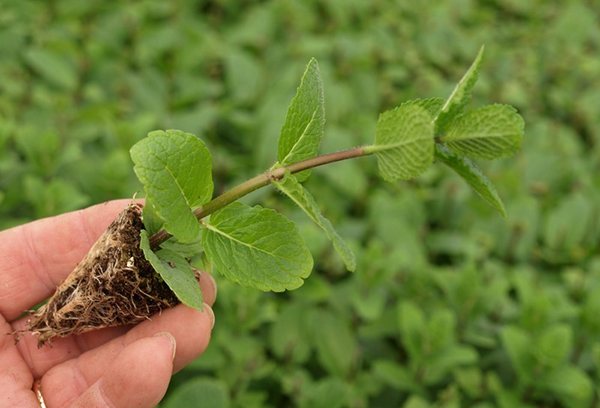

Mint care
Special care is not required for home mint; it is enough to perform a few simple steps:
- regular watering is also the main care. In no case should the soil dry out, since mint does not tolerate dryness well. However, you cannot fill the plant;
- dust removal. Using a sprayer, you should regularly remove dust from the foliage - this will make the mint only bushy and aromatic;
- top dressing. In the summer, you can feed with urea once (1 g / 1 l of water), in the winter, no feeding is needed;
- supplementary lighting. In summer, an abundance of light is not required, but from October to March daylight hours must be extended to 12 hours;
- direct sunlight is detrimental to foliage, so the plant must be hidden from it behind a light canopy;
- maintaining the temperature. Mint does not tolerate cold, the optimum temperature for it is 20-22 grams Celsius. In the summer, mint can (and should) be kept on the balcony, and in the winter it can be moved to the windowsill;
- leaves should be pinched off at a distance of 15-20mm from the stem, which stimulates the emergence of new shoots.
Caring for mint at home is not difficult and not burdensome, but you always have at hand not only fresh and tasty greens, rich in vitamins, improving sleep, memory, increasing the body's defenses, but also just a beautiful-looking bushy plant.
Growing mint at home Mint is a favorite plant of many. The refreshing scent of mint is unmistakable. Mint occupies a special place in cooking, it is found in both sweet and savory dishes, and a variety of mint-based syrups and sauces are also popular. But there is a problem, in winter it is difficult to find mint, even in stores, or the price is so heavy that it discourages any desire to buy it.So let's grow mint at home, it's not difficult. This can be done in two ways, sow with seeds, or plant with a cuttings or twigs.
Today we will tell you how to grow mint from cuttings in two ways. Mint cuttings can be taken at the dacha or taken from friends. Alternatively, you can use a few sprigs of mint that you bought from a supermarket or market. Just put them in water and wait until the roots appear. For the growth of mint, a comfortable temperature is 20-25 C. But if you do not have enough lighting, the mint stretches, so in this case it is better to lower the temperature to 15-17 C. Choose a loose, humus soil with a high content of peat. Purchased soil is perfect for this purpose. 1. Method. Clean the lower part of the branch from the leaves and gently stick it into the ground. Tamp the soil around. Water well. 2. Method. Put the mint sprigs in a bowl of water. After about 7-10 days, the roots will appear. Prepare a pot of soil, make a hole 5 cm deep, add a little water to each hole. Place the mint sprigs, cover with earth, and gently tamp the earth around each sprig. Water often at first until the plant takes root. You can also feed with organic feed. Mint loves moisture, but don't overdo it.
Thanks for watching. If you liked it, subscribe to our channel. If you do not understand something, need explanations or have questions, ask.
Link to video:
Features of growing mint on the windowsill and methods of reproduction
Growing mint at home on a windowsill is no longer considered some kind of exotic occupation. However, in order to grow a fragrant green plant at home, you need to take into account some features of planting and care, and most importantly, create suitable conditions (light and temperature).
There are several ways to grow homemade mint on the windowsill:
- If carried out sowing by seeds, then you need to be prepared for the fact that the seedlings sprout poorly and slowly.
- It is best to grow mint on a windowsill from cuttings, they take root faster and immediately begin to grow.
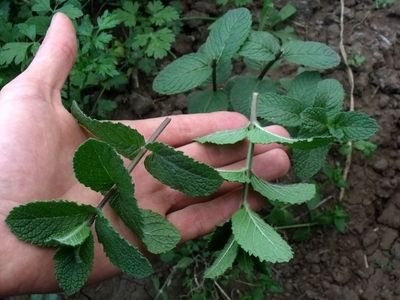

By the way! For grafting and growing at home, even the mint that you buy in the supermarket or in the market is suitable. The main thing is that it is fresh (be sure to look at the production date - cuttings and its appearance).
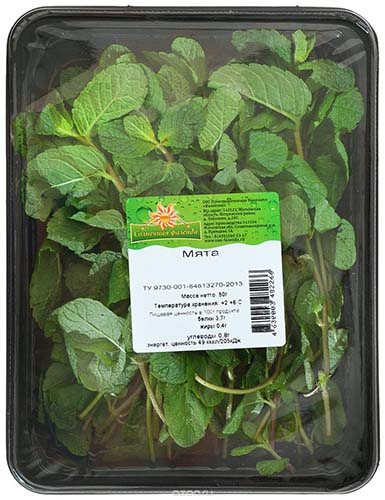

Video: how to grow mint at home in a few days
You can also just take and transplant mint from open ground into a pot.
Important! Many people face such a problem: after transplanting from the soil into a pot, the mint begins to dry, despite a sufficient amount of light, normal watering ...
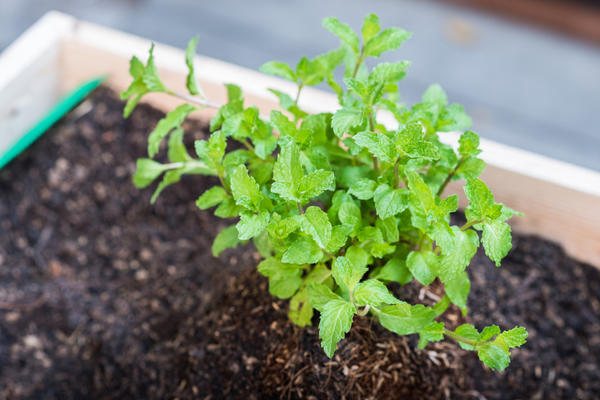

Interesting! At home, mint can grow for a very long time (10-20 years), and it will be the same plant. Naturally, it will grow over time, and when it becomes cramped in the pot, you can simply divide the ball into several parts. Extra bushes can be given to someone or simply thrown away.
Thus, growing mint on a windowsill is not too different from growing other plants indoors. The main ingredients for success are enough light, a comfortable temperature, and moderate watering.
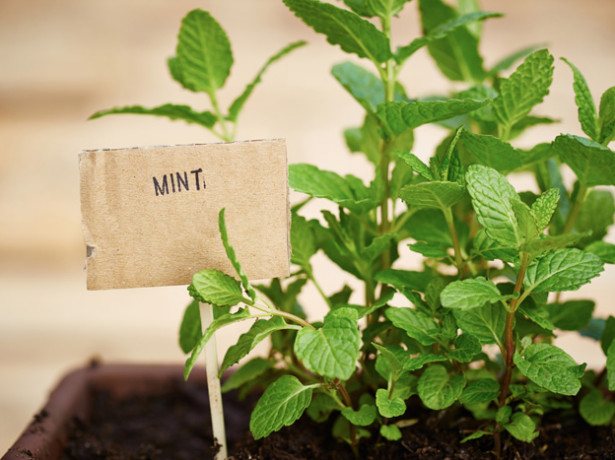

Video: features of growing mint on a windowsill
Note! Cats love to rummage around in containers of mint, so take care to protect the plants from pets!
Useful properties of mint
The beneficial properties of this plant are amazing. Peppermint is able to restore healthy sleep and relieve nervous tension. Since the time of Ancient Rome, the unique properties of mint have been used - according to the Romans, mint improves mental abilities, so a wreath of mint on the head of a philosopher or student was not uncommon during scientific discussions.
What else can be grown on the windowsill:
Growing ginger at home: pharmacy on the windowsill
How to grow arugula at home
How to grow basil on a windowsill
The plant is known for its analgesic and antiseptic properties, peppermint essential oil relieves vascular spasms, headaches and successfully fights colds. Eye compresses with mint decoction will be useful for people who spend a lot of time in front of the computer.
Essential oil is found in all ground parts of mint, so leaves, flowers, and stems are suitable for drying. Harvesting on your windowsill should be started when the plants are blooming with small purple flowers, so you will get a higher content of essential oils in mint. In summer, fresh mint leaves add refreshing lemonades. It is good to add mint not only to fruit salads, but also to meat dishes.
Store dried mint in sealed glass jars or paper bags to avoid moisture ingress.
Mint varieties for growing on the windowsill
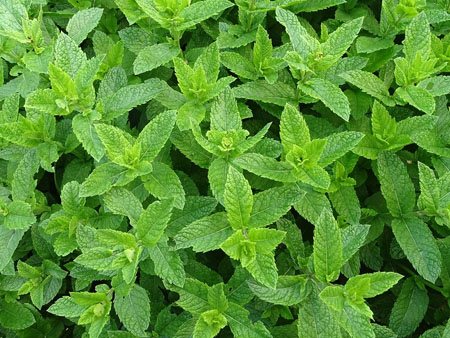

In the conditions of an apartment, the same varieties and varieties are suitable for growing as for open ground.
Of the popular varieties, it should be noted:
Speaking about which variety of mint is best to grow on a windowsill, you need to take into account the dimensions of the chosen place, the height and spreading of an adult plant. It is better to choose varieties that are characterized by small roots and a compact aerial part:
| Variety | Description |
| "Ceremony" | A small bush with leaves of a rich green color. It is rich in menthol and has a deep aroma. Great for culinary purposes. |
| "Fun" | Shade-tolerant variety. The bush does not exceed 50 cm in height. The taste of the leaves is fresh, menthol. |
| "Pennyroyal" | Compact bush with small purple-green leaves. The aroma is intense. It is used for making cocktails and other drinks. |
| "Spearmint" | Low (35-60 cm). It has oval dark green leaves. The aroma is strong, cooling. Ideal with meat dishes and salads. |
If room conditions permit, you can grow larger varieties: Menthol, Moskvichka, Garden Pepper.
How to grow mint on a windowsill
Site preparation and soil
To prepare the planting sites for growing mint at home, you need to take a wide and low capacity, because mint has a fairly branched and powerful root system. Peppermint loves slightly acidified soil, so peat-based mixtures are suitable. If you plan to take land from a summer cottage, choose the most fertile and fatty, mint will grow better, and the content of nutrients in it will be much higher than that of plants grown on poor soil.
Before use, the garden soil must be spilled with a strong solution of potassium permanganate, and then with water, or ignited. This is necessary for the destruction of pathogens.
Cuttings or seeds?
Mint can be grown at home from cuttings or seeds. The choice of growing method depends on how quickly you want to harvest.
Cuttings harvested in the fall (just dig up an adult plant in the fall with a good clod of earth and divide into seedlings), will allow you to get fresh greens in 10-20 days. These will be plants that exactly repeat the characteristics of the mother mint bush.
When sown with seeds, shoots appear in two to three weeks, and the process of plant formation will take a month or two, but in this case you will get very tender greens of young plants, while mint grown from rhizomes gives adult herbaceous stems, which are more suitable for drying.
But mint is a cross-pollinated plant that readily interbreeds with similar species. Therefore, the seeds can give plants that do not quite match the picture on the pack of the seed you bought.
The seeds of the plant are quite small, so when planting they are not covered with soil, and watering is carried out very carefully using a spray bottle.
Mint care
Caring for mint is not at all difficult, it can be called universal - these plants are very unpretentious.The secrets of growing mint at home are simple: regular watering and periodic feeding with any complex fertilizer once a month.
In summer, shade mint from excessive sun, it loves partial shade, but in winter it is better to put containers with plants on the southern windows, with a lack of light, the content of essential oils decreases sharply. And in winter, avoid over-watering, let the soil dry out. Otherwise, the roots can rot, and the plant will die.
In spring, summer and autumn, it is preferable to take the mint out to a closed insulated loggia so that the temperature does not exceed 15 degrees, but it is imperative to protect the plant from drafts.
Adult mint plants are quite tall - up to one meter. Therefore, when preparing the planting site, take care of sufficient space around the plants. Mint does not need props, its stems are quite strong.
Protection against diseases and pests
In the summer, you need to check if aphids and spider mites have settled on your mint. If you see the first signs of disease, it is necessary to apply plant protection products. Before using, be sure to observe the terms before harvesting, indicated on the pack of the medicine, so that the drug has time to disappear from the sap of the plants, and you get environmentally friendly plants on your windowsill.
Now you just have to prepare a little - find the necessary equipment, choose a place and determine your favorite mint variety to grow at home ... Pepper, lemon or maybe apple?
______ Irina Inari
Photo:
Along with this article, they usually read:
Window Watercress is just gaining popularity right now! In terms of the presence of vitamins and microelements, it is not inferior to ordinary lettuce, and the process of growing it is much easier! And the grown watercress "chik-chik" with scissors, and immediately in a bowl - beauty.
Unfortunately, it is not always possible to see fresh fragrant parsley on the dining table in winter. They didn't bring them to the store, or they are too lazy to leave the house and waste time buying one or two bundles of greenery. It is possible to survive its absence, but when the food is flavored with pretty fragrant leaves, life during the off-season becomes more fun and “tastier”.
The most common vitamin supplement, which, probably, everyone has tried to grow on a windowsill at least once, is an onion! Sprouted during storage? In his jar, water there, and on the window! However, if you want a delicious onion, and even decoration for the windowsill, then this method will not work.
Growing a fresh vegetable on your windowsill is a matter of course for most people in providing vitamins to their family. Cucumbers, tomatoes, onions - they all grow and are quite successful. But sometimes we forget about the place of the dill on the table, and therefore in the pot on the window.
Many people grow mint on their personal plot.
It's nice to feel its spicy aroma on a summer evening, to arrange a tea party with the addition of its leaves.
There are many varieties of mint, but peppermint is especially popular in gardening.
This is a perennial plant, quite winter-hardy, moisture and light-loving with a powerful root system, therefore, it is not recommended to plant valuable crops on the same bed with mint.
In one place it can grow up to 10 years, but with periodic replacement of plants.
Conditions for growing mint in the garden
The best predecessors of mint are root vegetables, legumes, perennials. Bloom from July to October. The height of the bushes is from 30 cm to 1 meter. In a frosty snowy winter, it does not require shelter, but if there is no snow, then freezing of the bushes is possible, therefore, mulching with sawdust or peat with a layer of 15-20 cm will be required. It responds well to fertilization, especially loves nitrogen and phosphorus. Do not allow thickening of the plantings, this provokes the appearance of powdery mildew on the leaves.When mint is affected by diseases or pests, treatment is practically useless, since any treatment of plants will make it unusable, so grow mint at a distance of 60-80 cm from a flower garden, other herbs and vegetables.
The soil for growing mint should be moist, light, loose, sandy loam or loam with a high content of humus. Does not tolerate waterlogging. Choose a plot sunny with midday shade, since with a long day, mint develops very quickly, this moment is especially important for those who grow mint for sale.
Can be planted in rock gardens, under trees. Mass planting of black peppermint will add an amazing decorative effect to the garden.
Planting mint
Before you start growing mint, remember that this is a creeping plant that can fill an entire area, like. So that this unpleasant situation does not happen before planting, you need to drive limiters into the soil, which will restrain the growth of rhizomes.
It can be sheets of slate or just iron hoops from barrels, or you can grow mint in the country and in large containers with drainage holes. Several varieties of mint can be grown in a garden bed or container, such as peppermint, apple, curly and Thai. Make variety for yourself.
Usually mint is grown from seed and propagated by cuttings or rhizomes. For seedling growing, buy and in mid-April start sowing seedlings.
Mint seeds are small, so it will be convenient to sow them either with the help of a sharpened wet stick or use the advice of summer residents with the help.
Spread the seeds over the surface of the soil, pressing them a little, cover with cling film and expose to the sunny side. In warm sunny weather, plants can be displayed outside the window. In mid-late May, the seedlings will be ready for planting in open ground, 3-5 pairs of real leaves should have formed on it by this time.
Before planting mint in the soil, apply organic fertilizers (per 1 sq. M. 3 kg of humus) and mineral (potassium chloride, superphosphate and ammonium nitrate, 15 g per 1 sq. M.), Adding 2 tbsp. wood ash, dig up the soil to a depth of 20 cm, level and make a bed in several rows, the distance between which is 40 cm.Plants plant at a distance of 30-50 cm from each other, deepening the rhizome by 5 cm.
If you want the mint to bush, then pinch the tip when the plant is 20-25 cm high.
- Mint can be grown by cuttings. To do this, cut off the tip of the shoots (7 cm) and place in water. When the roots appear, plant them in open ground every 20-30 cm, deepening by 5 cm.
- Growing mint by dividing rhizomes. Cut the rhizome so that each has 10-12 knots. Plant in holes to a depth of 8-10 cm. The distance between rows is 40-50 cm, and between plants is 30-40 cm. When planting mint rhizomes, it is better to add a small handful of humus to each hole.
Mint care, collection
Water daily in the evening in dry hot weather, loosen. In the spring, feed and regularly mulch the plants with the addition of compost and wood ash.
In the fall, before frosts, it is better to carry out a deep digging of the soil with the introduction of half-matured manure at the rate of 2 kg per 1 sq. M.
It is better to harvest mint during the flowering period, at this moment it accumulates the greatest amount of essential oil, and it does not matter how exactly to harvest, by pruning, pinching, or simply picking off the leaves. After collecting, a new development of the shoots begins. For harvesting for the winter: spread the collected parts of the mint on paper, dry, after which the leaves can be ground to a pollen-like state or left intact. Fold in a resealable container and store in a cool, dark place.
Mint is a very healthy and aromatic plant. It is added to tea to calm the nerves, improve mood and tune in to a sweet dream.And if you just touch the mint leaves, the space will be filled with a wonderful aroma. Therefore, many people want to know if it is possible to grow mint on a windowsill (especially in winter), and how to do it. Naturally, for this you need to have information about the basic rules for planting and caring for a plant at home.
Conditions for successful cultivation of mint
Plant container
Mint prefers containers with a wide base and low height for planting. The best option for planting on the balcony would be a ceramic pot. Remember that mint is endowed with powerful roots, which will be cramped and uncomfortable in a small pot. You can grow it in boxes or large flowerpots, depending on how much crop the gardener wants to get. Mint is quite fertile: from each square meter planted with a plant, you can get up to two hundred grams of dry raw materials.
Temperature and lighting
A comfortable temperature background for a plant is in the range of twenty-twenty-five degrees.
It loves lighted places, but not with scorching sunny leaves, if there is little sunlight, then mint shoots can dramatically stretch out, going into active growth.
Shade it in the summer months.
In such cases, the room temperature is reduced to fifteen degrees Celsius.
Features of growing mint on the window
Growing mint on the windowsill does not require effort and special skills. Indoor spice can be grown throughout the year, but preferably in the fall or spring months.
The optimal place for summer maintenance is a balcony, for winter - a window sill, where there is good lighting. Depending on the size of the bush, it can be placed on a shelf or on the floor. It is advisable to water from a pan with slightly warm boiled water. The leaves are periodically sprayed, cleaned of dust accumulations: this enhances the aroma.
In winter, the plant is dormant, growing slowly. It must be protected from cold and drafts. In the warm period, when growth processes are activated, the upper leaves should be cut off, leaving 2 cm of the petiole from the stem: this is necessary to stimulate the appearance of lateral shoots.
Soil and fertilizer for mint
The plant prefers to grow in soil with an acidic composition, so soil with the addition of peat will be a wonderful solution. If a gardener wants to plant mint in the soil from a summer cottage or garden plot, it is necessary to choose the most fertile and high fat content. The best growing of mint takes place in such soil. Before planting it, it is necessary to spill the soil with a manganese solution, then pour it well with plain water, you can ignite to eliminate all bacteria. It must be fertilized after rooting and the appearance of two or three leaves, using an ash solution.
Choosing a site
It is better to take a sunny place for growing mint, on which there is a shade at noon. Its bushes develop faster with long daylight hours. Constantly being in dense shade near the walls of buildings or under spreading trees, they will not die or wither, but their growth will slow down.
Peppermint is undemanding to soil quality. A soil that meets 5 conditions is ideal for her:
- easy;
- porous air and moisture freely passing to its roots;
- containing a lot of moisture, but not swampy;
- humus-rich;
- loamy or sandy loam.
If the soil in the area contains a lot of lime, this will not interfere with the cultivation of mint, but its leaves will give off a weaker aroma. Dense clay soil, in which water stagnates for a long time, is contraindicated in culture. Even proper care on such land will not save the plants.
Before planting mint, the site is prepared in the standard way: weeds are selected, they are dug up, fertilizers are applied. Both organic and mineral compositions are suitable for her. The height of the beds is determined by the type of soil.If it dries quickly, it is better to make them low. This will help keep the moisture in the ground for longer. If the soil in the country is damp, it is worth pouring high ridges. They will protect the roots of the plant from decay.
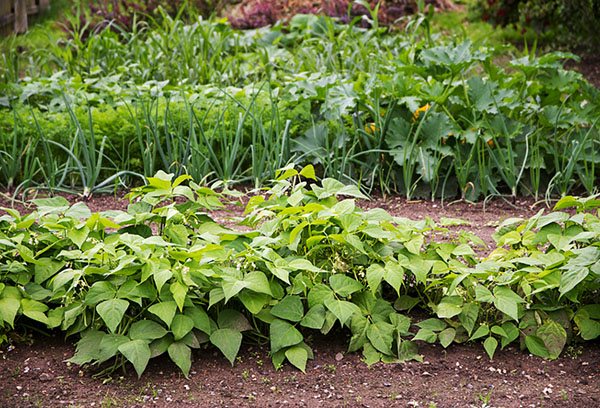

How to get an adult plant from a cutting?
Cuttings are harvested in advance, it is best to do this in the autumn months, when the plant ends the growing season. The root is removed from the soil along with an earthen lump and removed until spring in a cool place, lightly sprinkled with sand. Any kind of mint can be grown from the cuttings. Before planting the mint, the root is divided into several parts. In each of these parts there should be at least a pair of root suckers with buds on them. They must be planted in a flowerpot or large box, where the soil is laid in advance, not completely filling the container. Having laid the cuttings, they are sprayed with moisture on top and sprinkled on top with the rest of the soil. Mint begins to grow rapidly, during this period it is necessary to water them abundantly with water with diluted urea, diluted in the proportion of one gram of substance per 1000 milliliters of water.
Once a month, the mint "sitting" on the balcony needs to be fertilized once every thirty days. During the summer, the plant is often sprayed with water. Remember that it grows tall, but the stem of the plant is strong and will not fall off without support. Mint requires an abundance of space around its container.
Benefits of mint
Mint is famous for its abundance of vitamins and minerals.
She is rich:
- thiamine,
- riboflavin,
- folic acid
- calcium
- magnesium
- phosphorus
- iron
- zinc
- potassium.
This is just a part of the useful components that make up the plant. It is widely used in folk medicine. Mint is able to relieve pain and spasms. It strengthens the nervous system, demonstrates an anti-inflammatory effect, and activates the brain. This plant is often used in cosmetology to cleanse the skin.
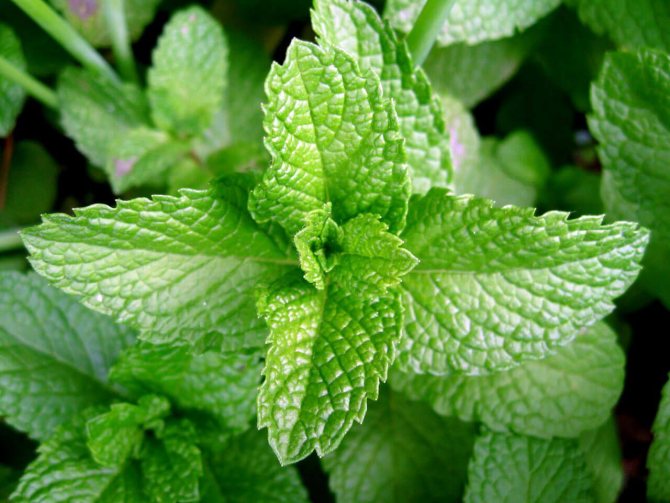

Digestive problems
Peppermint is ideal for aiding digestion. Mint leaves contain antioxidants and phytonutrients that are good for the stomach. The mint aroma helps to activate the salivary glands, which produce digestive enzymes, enzymes vital for digestion. They relax the abdominal muscles, which reduces the likelihood of stomach cramps and indigestion.
Mint leaves help clear acne and acne and give the skin a radiance due to its high content of antioxidants. Also, the scent of mint soothes itching from insect bites. To do this, a mint leaf is rubbed at the site of the bite of a mosquito, midge, hornets, wasps and bees. The mint scent can repel insects to prevent new bites.
Species of mint


- Peppermint. Obtained by selection of wild, water and spikelet varieties. The second name is English mint. Its leaves are high in essential oils. It is an excellent honey plant. This type of plant reaches a height of one meter, unpretentious, does not require special care. It is often used in manufacturing menthol. It serves not only to obtain additives in food and medicine, but also to make menthol oil.
- Field mint. In Tibet, this plant is used to treat tuberculous manifestations, diseases of the digestive system. Treat her gastritis, liver disease, bowel problems. It is also effective for a complex of treatments for weight loss. With aromatherapy, a person simply naturally reduces appetite by reducing the amount of calories consumed.
- Lemon mint. The second name of this plant variety is lemon balm. It is a good melliferous plant, a frost-resistant plant, but easily freezes in the winds, in this regard, it is sheltered for the winter period. It is best to plant it with seedlings. It is susceptible to fungal diseases and is valued as a spice, not a medicinal component. The taste is similar to a mixture of citrus fruit and mild mint coolness.
- Flea mint. It is effectively used in the fight against insects, its active substances are pulegon and limonene.The plant is creeping, of short stature, similar to thyme. Loves warmth, looks aesthetically pleasing, perfectly repels insects if grown on the balcony.
- Curly mint. It is also called German. It is often used as an amulet and serves as an attribute for rituals aimed at protecting the home and everyday life. Its smell is harsh, growing from thirty centimeters to a meter in height. Its leaves are small, and the flowers have a persistent aroma.
What conditions do mint need for successful growth?
Mint is a perennial, so for its cultivation you need to create the necessary conditions right away. It is important to decide where to plant mint on the site, which plants will feel comfortable nearby, what requirements mint makes to the composition of the soil, lighting, watering.
It is best to plant mint in an area previously occupied by legumes and root vegetables. Plants such as buckwheat or melon are also considered good precursors for mint, as they tend to saturate the earth with the calcium it needs to grow properly.
When choosing where to plant mint next to, it should be borne in mind that any pesticides exclude the possibility of using this plant, so there should be no flowers, vegetables, or other valuable crops in the immediate vicinity of mint.
Features of the choice of lighting for mint
For mint, you need to choose a warm, sunny place, protected at the same time from the scorching midday rays. Mint is a moisture-loving plant, therefore it perceives drying out very badly.
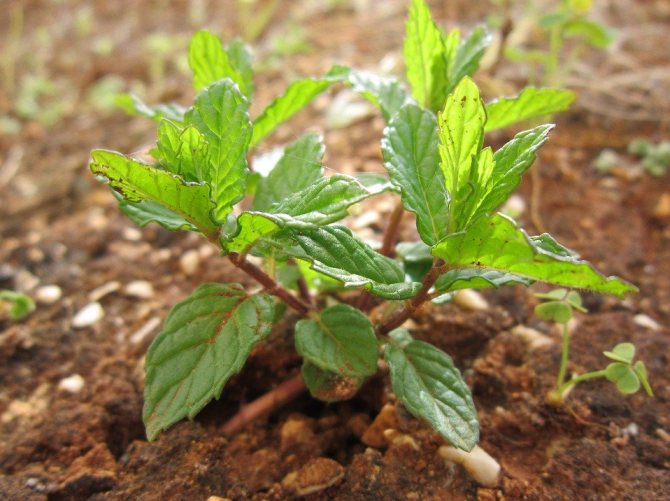

The sun should illuminate the mint for at least four hours a day, while in the middle of the day it is better for the plant to be in partial shade. For growing mint indoors, the south, south-west or east side is optimal.
Long daylight hours accelerate the development of mint, so if the plant is intended for implementation, the time of active lighting of the site can be artificially increased. If there is not enough sun in the area, this will not be a serious obstacle to the growth of mint, provided that the plant is not oversaturated with moisture.
What should be the soil for growing mint
Mint needs to provide light, loose soil with a moist and deep fertile layer.
The pH level should correspond to the range of 6.0-7.0. Sandy loam soils and loam are well suited to the plant. On swampy soils, mint does not take root.
To prevent the soil from drying out, it is recommended to use mulching.
The plant needs organic, nitrogen and phosphorus fertilizers. You can feed mint 1-2 times a month.
The soil on which the mint grows should be well dug twice a year and weeds should be weeded constantly, as they can damage the root system of the plant.
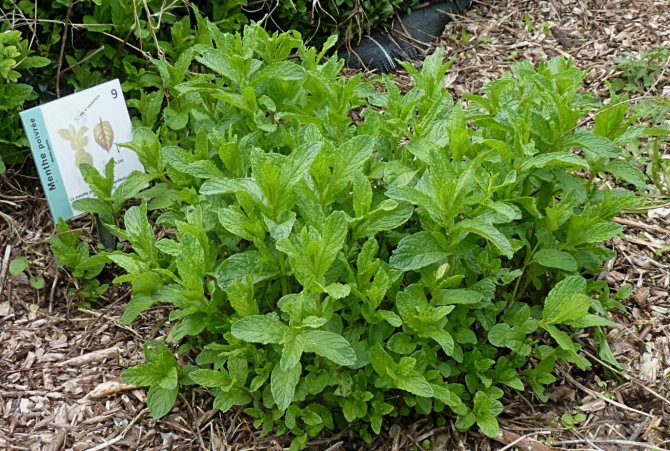

Ripening terms
Start cutting mint in June, when the shoots reach a height of 20 to 30 cm. However, the leaves are richest in essential oil before flowering. Pruning stimulates the awakening of the buds on the rhizome and the regrowth of new shoots, does not allow the plant to waste energy on flowers.
The active growth of mint continues until August. In three months, you can get 2 full harvests of fragrant leaves. Shoots grow "in waves": the very first are ready for cutting in June, others "ripen" by July or August.
Harvesting
Cut leaves can be immediately brewed with a pinch of black or green tea, added to dessert, or made into a cocktail. Such consumption of mint from a pot on a windowsill is available almost all year round.
Mint tops with flowers are not harvested for drying or freezing. They contain little essential oil and are therefore not suitable for tea or salads. Shoots before flowering are considered mature, suitable for mass collection.
Use clean, sharp scissors or a knife to cut. Harvest in the morning. Tear off only the leaves, they are richer in essential oil. Alternatively, cut off the shoots by 2/3, dry them whole, spreading them in a thin layer on a paper towel.
Important! There is no need to cut the raw materials into pieces, as is done in pharmacies.The essential oil volatilizes during grinding.
Dry mint in a ventilated room, without access to the sun, turn the raw materials daily. Properly dried herb retains its natural green color, pleasant "cooling" aroma, and a slightly pungent taste. The faster the drying process, the more nutrients it contains.
When to plant mint
Mint is a frost-resistant plant, therefore, planting can be done with equal success in spring, summer, and autumn, you just need to decide on the planting methods.
If you plant mint in spring
In early spring, you can sow mint seeds in the open field, since it makes no sense to sow them in the fall - they will simply freeze over the winter. Summer is also not suitable for this method - young plants will not be able to root normally before the onset of frost.
The same can be said about vegetative planting methods - spring, but not early, the most appropriate time for planting.
Is it possible to plant mint in autumn
With the help of cuttings and root layers, mint can be planted in the spring, and in the summer, and in the fall. Here the advantages of the climate must be taken into account.
For colder areas, it is better to plant the plant before the end of August so that it can take root before the frost begins.
In addition, with sufficiently late plantings, it is necessary to protect young shoots for the winter by mulching the soil with a rather large layer of peat - about 20 centimeters.
For the autumn period, planting may be the latest by dividing the bush, the main thing here is to have time to do this at least a week before frost.
Why dried mint is good for you


Peppermint is used in many herbal preparations, so every gardener tries to make space to plant this plant. It is not whimsical to care for, it develops well in our climate. If you know when to dry mint for the winter, you can get several bags of this aromatic herb. Mint leaves contain special substances that help:
- relieve itching, because the plant has a vasodilating property;
- in the treatment of gynecological, cardiac, intestinal, gastric diseases;
- soothe a toothache;
- add tone to the entire body.
- What perennial flowers need to be covered for the winter - how to choose the right material and method of insulation
- What catnip looks like and how it is used, how is it useful for cats and for humans
- How to properly prune onions for winter storage after harvest
Agrotechnics
Leaving mint growing in the country is almost not required. Freshly planted bushes are often watered. Better to do this in the evening. Mature plants are less hydrated. In a rainy summer, mint will have enough natural precipitation; in dry weather, it is watered once every 1.5-2 weeks. Planting needs to be weeded and loosened regularly. Mint roots are located almost at the surface of the soil, so the weeds are a big hindrance to them. It is more convenient to carry out such care after watering or rain, while the ground is still wet. It is easier to remove weeds from wet soil without damaging the mint roots.
The culture responds well to feeding. It is better to take for them preparations with a high content of nitrogen and phosphorus, but organic compounds can also be dispensed with - rotted manure or compost. Care is especially important for mint in the form of dressings during the period of active growth of its bushes - in the spring. In the future, the beds are mulched from time to time, adding wood ash to the compost. In the fall, professionals recommend digging deep into the soil, adding half-rotted manure into it (2 kg per 1 m²).
Advice
The plantings need to be monitored, not allowing them to thicken. Powdery mildew can attack the mint.
If you want to get bushy plants, they are periodically trimmed, shortening the top. Then the mint ceases to stretch upward and begins to actively form side shoots. As a result, more fragrant leaves can be harvested from it. If the mint bushes are strongly stretched in height, you should pay more attention to watering.Usually the plant reacts in this way to a lack of moisture.
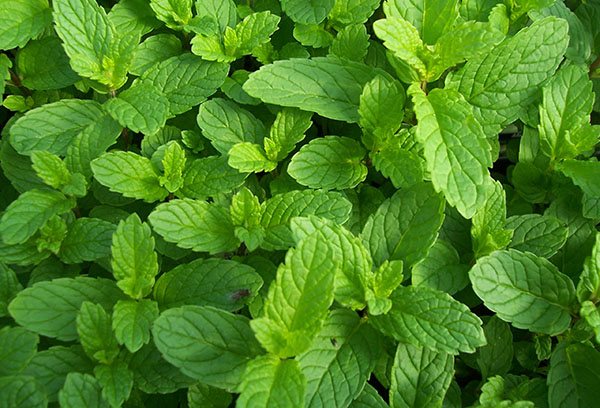

Pests and diseases
Growing mint is damaged by a mint flea... Control measures are similar to those recommended against cross-flowered flea beetles. This insect gives only one generation per summer. The plant is harmed not only by adult beetles, but also by their larvae (roots). The mint flea pupates in August. This means that in the fall, after the second harvest of mint, you can treat the garden bed with karbofos (10% emulsion concentrate) 60 g per 10 liters of water.
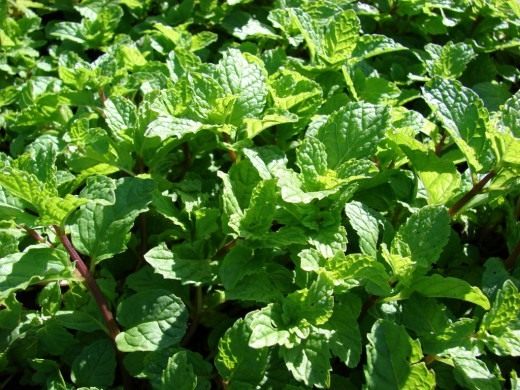

Garden spearmint (Mentha spicata).
In vegetable gardens located in low damp places, mint noticeable damage is caused by beetles and larvae of the mint leaf beetle... Like the previous pest, this insect can damage leaves. Unlike other plants, fusarium in mint manifests itself differently - the plants lag behind in growth, wither, the stems at the root collar darken and rot. Effective control measures have not been developed, but it has been noticed that excessive dampness of the site contributes to the development of fusarium. Enhanced ventilation of the plantation, adherence to high agricultural practices and limited watering is necessary.
Powdery mildew also affects mint... It manifests itself in the form of a white spiderweb bloom on the leaves, and black dots also appear at the end of summer. Control measures - weeding, sparse planting and on a seed plantation twice, after 10-12 days, spraying with a 1.5% solution of colloidal sulfur with the addition of 40 g of liquid (potassium) or green soap to 10 liters of solution.
Mint rust... Infected plants develop orange spots on the underside of the leaf blade. The infection infects plants through the roots. Affected plants must be removed and must not be fertilized.
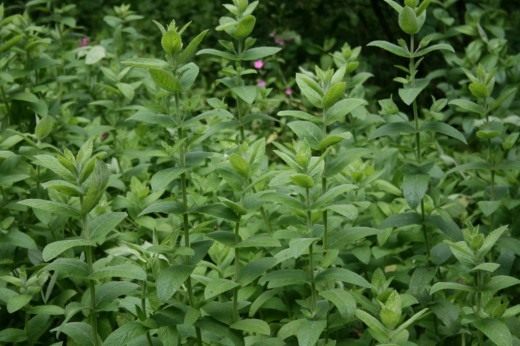

Long-leaved mint (Mentha longifolia).
Aphids. Insecticidal oils and soaps are suitable as a means of control. The biological enemy of aphids is ladybugs.
Mites... Small arachnids of different colors (red, brown, yellow or green). They damage leaf cells and feed on cell sap. Affected plants wilt, brown spots appear on the leaves. Natural enemies are ladybugs. For control, you can use streams of water or insecticidal soaps.
Fatigue
Sometimes mint scent is all you need to invigorate, because it is a natural stimulant. The scent of mint helps to cope with stress, relax the body and calm the mind, and it also promotes the production of serotonin in the body. So next time you need to cheer up, fill your bathtub with warm water and add mint leaves.
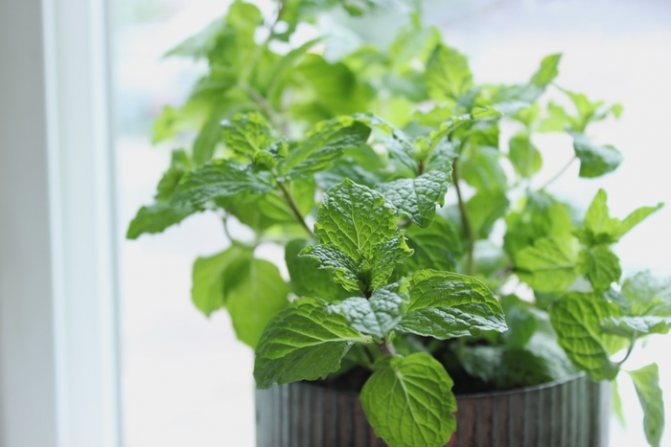

How to choose quality planting material
Planting material for planting mint can be obtained in various ways - buy it in a store or nursery, order online, make it yourself (if you are already growing this plant), or ask trusted friends. Each of these methods has its own advantages and disadvantages, the final decision depends on many factors.
Selection of seeds for planting
Self-collection of seeds from the mother plant is a rather painstaking and complicated process. In addition, artificially created mint varieties often produce seeds from which not a mother plant grows, but a completely different variety - from those used by breeders to breed a hybrid.
First of all, this danger relates to peppermint, which, as you know, is the most popular among gardeners. Of the curly mint seeds, about two-thirds do not inherit curliness and are a common wild variety.
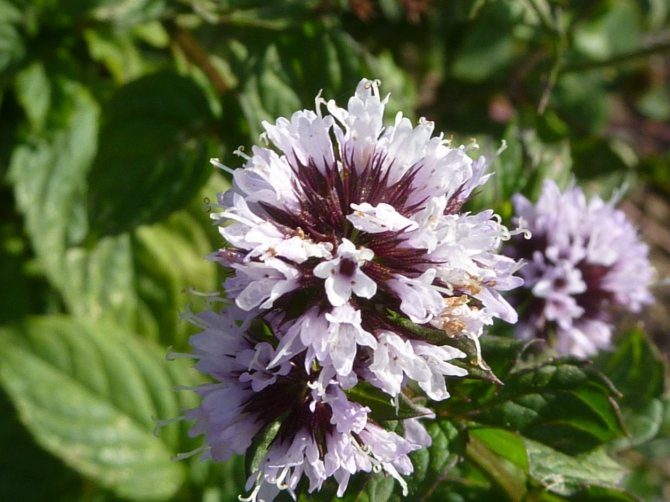

Therefore, it is recommended to buy seeds for planting mint in specialized stores (it is better, of course, for the manufacturer to be reliable and proven), such seeds give stronger and more friendly shoots.
How to choose mint seedlings
Mint does not reproduce well by seeds, therefore it is better to leave this matter to experienced gardeners.It is much easier to purchase ready-made mint seedlings, especially since there are many options for this.
Specialized store - a place where, as a rule, several varieties of seedlings are presented, from which you can choose a plant to your taste. The same applies to farmer markets, however, purchasing seedlings from unverified breeders is dangerous because the plants can be infected with pests or diseases, which can subsequently not only destroy the seedlings, but also cause serious harm to other inhabitants of the garden plot.
As a material for future seedlings, you can use an ordinary shoot from an adult plant, which is available in your neighbor's country house or in a friend's pot. To do this, cut off the sprout with a sharp knife or scissors at a height of 1 cm from the junction with the trunk of the mother plant. This sprout is placed in a glass of water, and when the white roots launched by it reach 5 cm in length, the seedlings are ready!
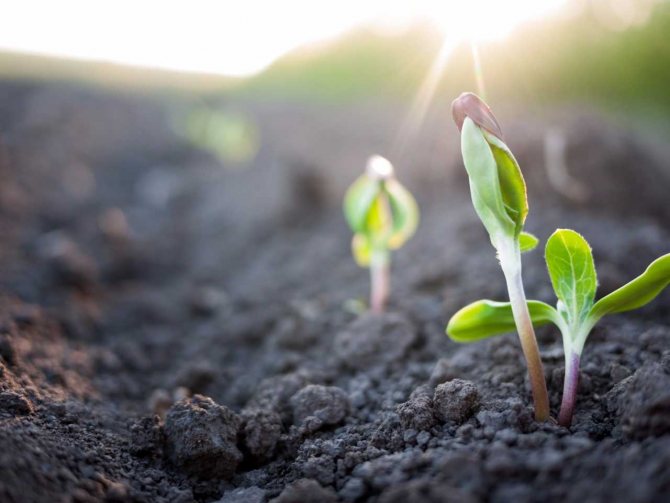

The same procedure can be done using mint, which is sold at grocery stores in supermarkets or in the market. This method does not guarantee a good result, but, in the absence of other options, it can be used as an experiment.
When choosing mint seedlings, you should pay attention to its appearance. Plants should not be lethargic, dried out, the height of the shoots should not exceed 6-8 cm, otherwise it will be difficult for the plant to take root.
Landing rules
When growing mint outdoors, you need to take into account the characteristics of the culture. Its bushes develop quickly, giving many shoots and filling the garden with themselves. To prevent the site from turning into continuous thickets of mint over time, the space allotted for it must be limited by driving sheets of slate or metal into the soil. Iron hoops cut from old barrels will also help.
Advice
It is better to place different varieties of mint on the garden bed. Pepper, curly, fragrant, apple varieties go well with each other and pleasantly diversify the menu.
Before planting plants, the soil is enriched with the following fertilizers:
- humus;
- potassium chloride;
- ammonium nitrate;
- superphosphate;
- wood ash.
Having dug up the soil 20 cm, level its surface and make a bed with wide (40 cm) row spacings. Mint bushes are planted with an interval of 30-50 cm. The rhizome is embedded in the soil to a depth of 5 cm. Plants will bush if you pinch their tops. They do this when their height is 20-25 cm.
Spring (in April-May, depending on the region) and summer (in August) planting of mint is practiced. In both cases, the procedure ends with abundant watering. If the planting of a crop on the beds is carried out with seeds, the furrow prepared for them is thoroughly moistened, and after sowing it is lightly sprinkled with dry soil. She will perform the function of mulch.
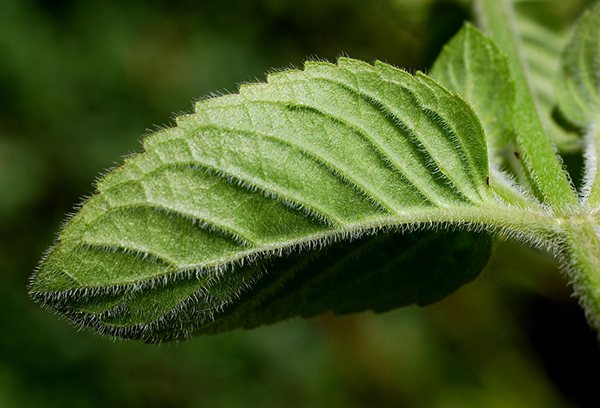

Suitable species, varieties and varieties
Mentha is a genus of perennial grasses of the Lamiaceae family. Many shoots extend from a branched rhizome, located almost horizontally, and thin roots. Mint is used as a pot and container plant. The main thing is to provide adequate lighting, regular watering.
Mentha piperita - M. pepper
It is a hybrid of two natural species (M. spikelet and M. aquatic). The stem is 20 to 60 cm high, tetrahedral, branched, densely leafy, reddish at a young age. The leaves contain a variety of essential oil glands.
Spikelet inflorescences are located in spike-shaped inflorescences at the tops of the stems. Corollas are small, pale purple, lilac or pinkish. Flowering begins in June and lasts until autumn.
Peppermint is rich in menthol. When rubbed or touched while leaving, the grass emits a pleasant aroma-chill. This hybrid is popular as a tea, medicinal, cosmetic plant.
Peppermint subspecies: black with reddish-purple hues, white with light green stems and leaves.Black mint is grown for the industrial production of essential oils and menthol. The essential oil of the white variety is more delicate.
Window sill and balcony varieties:
- "Lemon", "Orange", "Bergamot". The leaves are rich in menthol, antioxidants, used for drinks, decorating various dishes, improving the taste of sauces, compotes, jams. The aroma corresponds to the "speaking" names.
- "Apple". Leaves with a delicate taste, fresh apple notes. The variety is popular for fresh salads, drinks, ice cream.
- "Strawberry". Suitable for balcony cultivation. The leaves taste like ripe strawberries.
- "Chocolate". Leaves with taste and aroma of mint chocolate. Fast growing variety.
It is difficult for a layman to recognize a plant without a label, "badge". You can choose according to the description the most suitable in height, requirements for care, use.
Other popular types and varieties of mint
Spikelet M. is a plant with curly leaves. Pubescence in the form of short hairs. The flowers are white or pinkish. The species is poorer in essential oil and menthol than modern varieties, therefore it is less valued in medicine and cooking.
Water mint is a plant up to 90 cm high, with pink globular inflorescences, ovoid leaves and pubescent stems. Long-leaved M. has an impressive size (up to 1 m and more), more suitable for growing in the garden.
The varieties of mint "Banana", "Pineapple" are obtained on the basis of several species and hybrids. Use the leaves with a delicate fruity aroma and delicate taste for sweet dishes and drinks. Mojito is especially good for soft drinks. Moroccan mint, which is gaining popularity in Western Europe, may lack sun in central Russia.
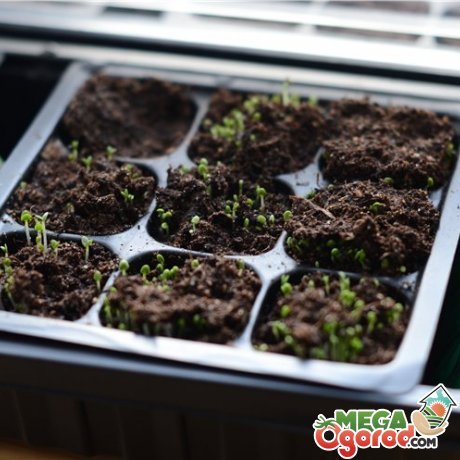

Varieties for cultivation
There are infinitely many varieties of mint, each with its own special aroma - lemon, pineapple, grapefruit. Some people grow several different varieties in one pot at once, it looks very impressive.
Peppermint varieties with a classic smell are most often chosen for growing on a windowsill:
| Krasnodarskaya |
|
| "Strawberry" |
|
| "Fun" |
|
| "Medicinal" |
|
| "Moldavian" |
|
Asthma
Since peppermint helps clear the airways, regular use is ideal for those suffering from asthma. Asthmatics are advised to add peppermint by inhalation and drink peppermint tea. To instantly ease breathing, add 4-5 mint leaves to hot water and inhale.
Peppermint contains rosmarinic acid, which acts as a powerful antioxidant that helps with allergies.
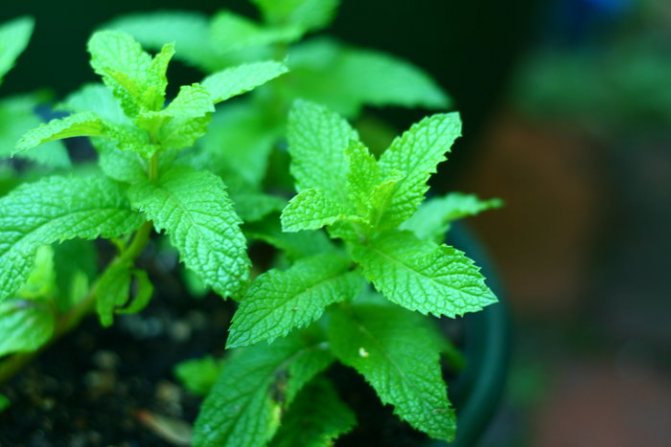

How to collect and store greens
You can harvest the crop already in the period before and the beginning of the appearance of purple-pink flowers. At this time, the leaves are gaining the greatest amount of essential oil. In winter, you can always pluck as needed for household or culinary needs. For example, they often decorate salads with mint, throw them into a teapot, make lemonade,
For drying, use the whole plant - along with the stems. Store the dry mixture in a glass jar, away from damp places. Plucked and unused petals can be filled with water and frozen. They will not lose their taste and aroma after defrosting.
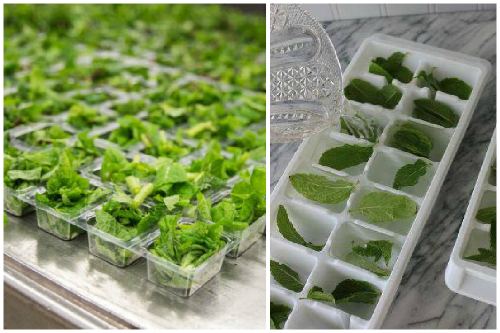

As you can see, there is nothing difficult in the care and cultivation of mint on the windowsill. You need to have desire, patience and a little time to end up with a plant with fresh, fragrant foliage.
Other breeding methods
Peppermint is propagated by cuttings or rhizome cuttings. Both methods allow young bushes to retain all the properties of the mother plant. Mint cuttings can be cut when they have 5 leaves each and a renewal bud is formed. Their length should be 7 cm. Having placed them in a prepared ridge, sprinkle mint cuttings with soil and water abundantly. It won't take long to root them.
Another method is also popular. Cut the cuttings are placed in a container of water and kept in it until the roots appear. They do not need any care at this time.It will only be necessary to add water from time to time as it evaporates. Then the cuttings are planted in the beds with an interval of 20-30 cm.
If you need to get pieces of mint rhizome, it is removed from the ground and slightly dried. The division is carried out so that each part consists of 10-12 nodes. The resulting rhizomes are placed in shallow (8-10 cm) holes. They are made at a distance of 30-40 cm from each other. When planting a cut, a handful of humus is thrown into the hole.
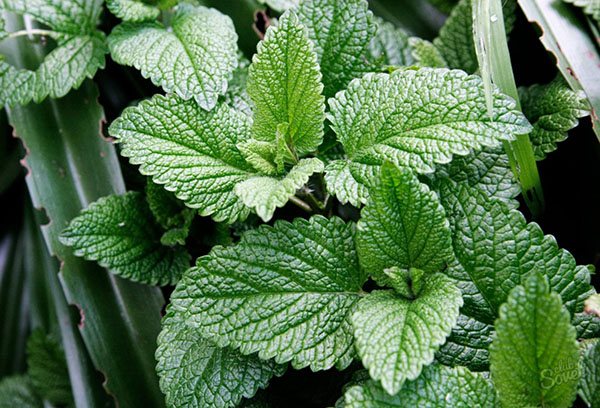

Danger in the vegetable garden
Mint is a great honey plant. And it also contains natural phytoncides - biologically active substances that kill harmful microbes, can even prevent the spread of typhoid fever, dysentery and other infections. These very valuable qualities make mint an attractive crop to grow.
However, there is a serious nuance here. And if you do not take it into account, you can face a big problem when cultivating this crop in the garden. This plant will instantly fill the entire area with its shoots!
She has such a rapidly growing root system, similar to a cobweb, that it will not be at all easy to uproot this perennial from the site later.
Therefore, before planting this beautiful herb in the garden, you need to take some precautions. Some gardeners dig deeper sheets of metal or slate around the mint beds to keep the roots from spreading.
But there is also an easier and more effective way to save the beds - to plant the mint in a suitable container (pot, bucket, old basin). Then this container, together with the mint planted in it, is dropped into the soil, leaving only a rim on the surface. This option will give 100% protection against the encroachments of this all-pervading neighbor.
Contraindications to the use of the plant
Mint, like any medicine, can negatively affect the health of the body. Therefore, it is important to know when to stop using mint in any form. Can not use:
- if you have hypersensitivity to menthol;
- driving (causing drowsiness);
- with the simultaneous use of anticonvulsants, antifungal agents, antibiotics,
- preparations containing iron, medicines to lower blood pressure;
- inside for children under three years old;
- with varicose veins.
Uncontrolled use of mint can lead to heartburn, as well as a decrease in male potency.

